 Mansfield and Mickey Hargitay ride into the gossip columns. 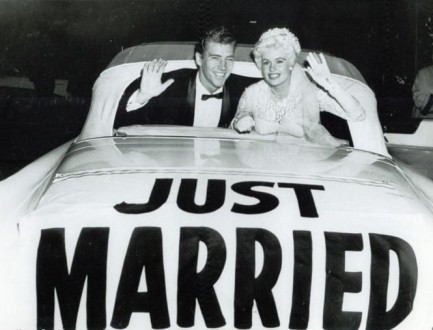
Jayne Mansfield rides off into the night with her new husband, Hungarian bodybuilder and former Mr. Universe Miklós Hargitay, better known as Mickey Hartigay, after their wedding in Portuguese Bend, California, today in 1958. In addition to riding off with Mansfield, Hargitay rode into the pages of the tabloids. As a noted figure in the fitness and bodybuilding world, he had been moderately famous before, but now, as a superstar’s husband, his every excursion, utterance, change in appearance, and career rumor was exhaustively documented and sold to the public. The marriage lasted six years, which is not bad by Hollywood standards, and the pair had three children, one of whom is actress Mariska Hargitay. See more on Mickey here.
 Tabloid tells curious readers everything they always wanted to know about things that are none of their business. 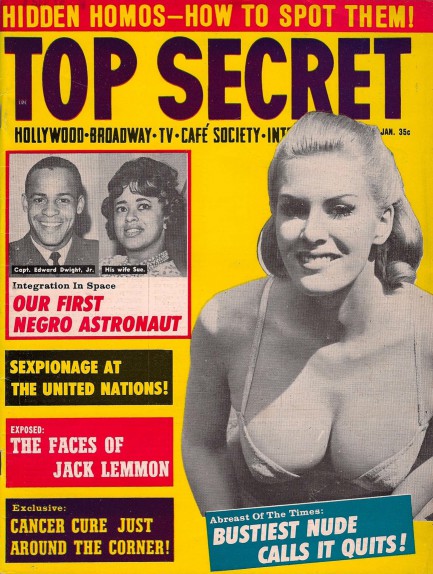
The last time we checked in on Top Secret was with their October 1962 issue. Today we’re visiting January 1964 and plenty has changed in the intervening months. Foremost—the paper and printing quality have degraded to what surely must have been the lowest standard available at the time, which is why our scans are grainy. But we can still recognize June Wilkinson on the cover, who we’re told is retiring from modeling, and inside readers hear from Ursula Andress, Jack Lemmon, Brigitte Bardot, Shirley MacLaine, Mandy Rice-Davies and more. Editors also tout “one of the most earth-shaking advances in the exploration of outer space!” Wow. Was it warp drive? A transporter beam? A stargate? No. It was that America’s newest astronaut, Edward Dwight, Jr., was a different skin color than the other astronauts. We might deign to call that an advance in the attitudes of NASA during an age of state apartheid. Space travel, on the other hand, remained space travel, unchanged. Top Secret implies Dwight was the first black American qualified to be an astronaut, and by so doing avoids admitting that the door was simply closed before his arrival. You know this game—all backslapping, zero introspection. But we get it. “Our First Negro Astronaut!” is a bit more celebratory than, “We should have done this from the beginning.” But we must move on, because the real gem in this issue comes later, in the story you see announced in the cover’s blazing red banner: Hidden Homos—How To Spot Them! Goodness, where to begin with this? First, we’ll say we would dearly love to reproduce this entire article as an artifact of an intellectual dark age, but it’s Saturday, and time is fleeting. Just know that the language is baroque in its viciousness. The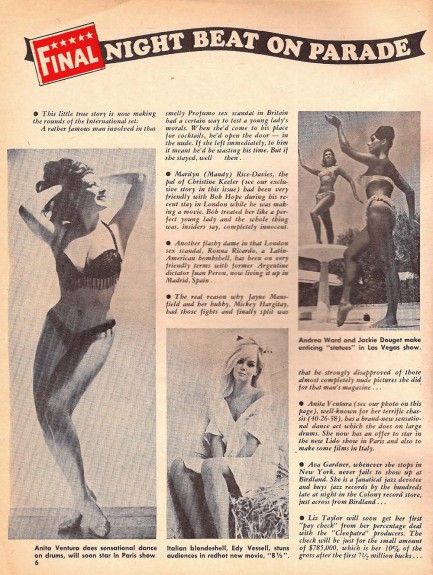 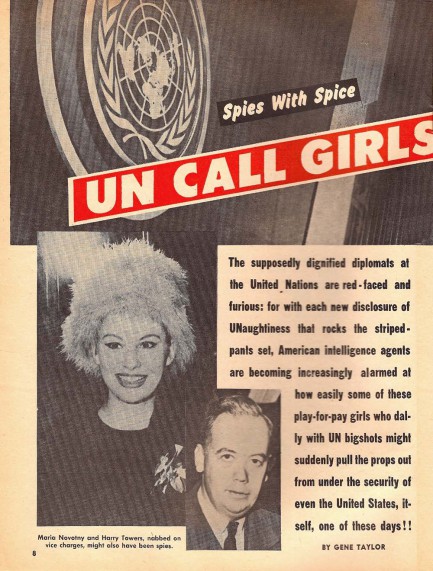 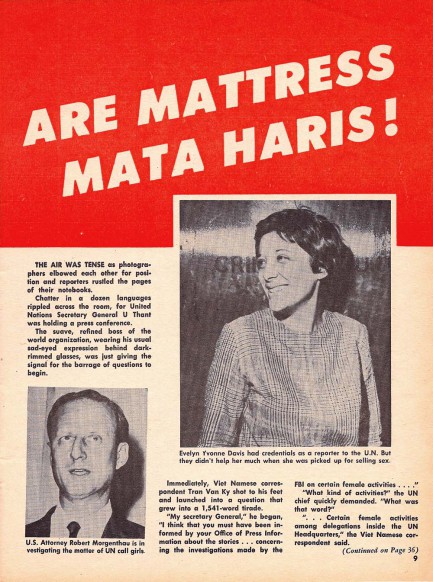 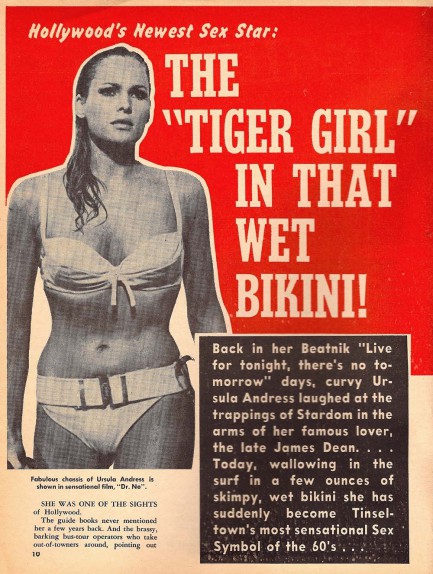 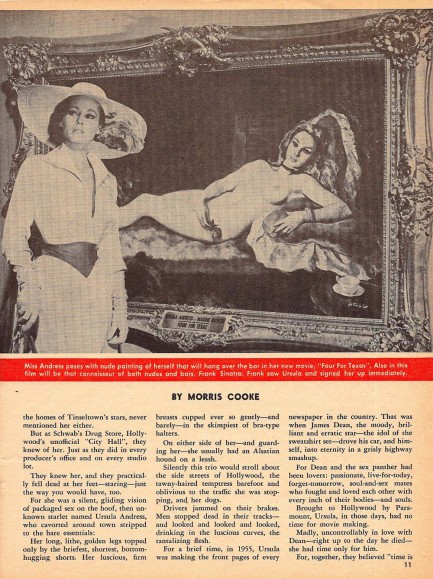 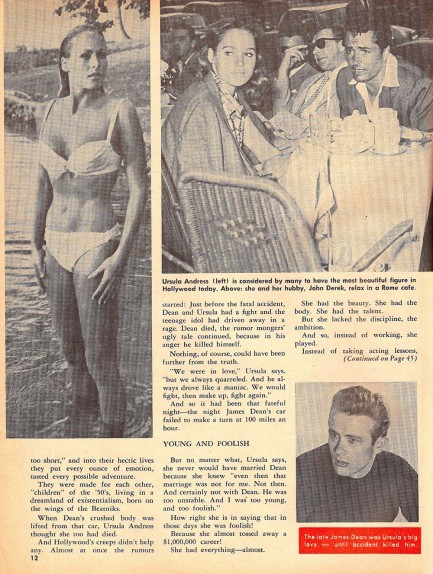 story begins with the tale of a company president who unknowingly hired a gay man and had no idea until several years later when the hiree—now a manager—got drunk at a company party and began slapping and scratching another man. Soon four employees were involved in this spat. The company president exclaimed: “My God! Those men are all queers!” story begins with the tale of a company president who unknowingly hired a gay man and had no idea until several years later when the hiree—now a manager—got drunk at a company party and began slapping and scratching another man. Soon four employees were involved in this spat. The company president exclaimed: “My God! Those men are all queers!” Top Secret explains: “Once the camouflaged homosexual has gotten himself a snug berth, he starts easing others of his ilk into the office. Before long, most of the straight male employees are out on their ears and the camouflaged fags have taken over.” Editors then list the eight most common types of gay men against whom normal, red-blooded Americans must be vigilant (by refusing to hire for any sort of job, potentially harassing out of the neighborhood, and possibly reporting to the authorities). Ready? Here we go with a few highlights: 1: The Overly Fastidious Dresser—obsessive interest in clothes is a feminine trait, and in men it may well be a danger signal. 2: The Overly Hygenic Type—their faces are invariably too-closely shaven. They make a fetish of washing their hands. 3: The Uriah Heep Type—he seeks to prove how very humble and insignificant he is by heaping praise upon others. 4: The Maiden Aunt’s Delight—these men associate with older women because such women make no heterosexual erotic demands upon them. 5: The Solitary Drinker—although he is not gregarious or even friendly, his eyes are constantly roving, covertly peering at others in the bar, particularly other men, seeking a sign of recognition from another secret swish. When he sees one he will give a signal in return and soon both fruitcakes will depart to enjoy a “courtesy exchange.” 6: The Octopus—they put their hands on other men’s shoulders, dig them in the ribs, slap their thighs… 7: The Middle-Aged Mama’s Boy—such an obvious Oedipal situation may indicate homosexual tendencies or homosexuality in adult men of any age, married or single. 8: The Youth Lover—he is constantly engaged in youth work, organizing clubs, leading outings, playing the part of the jolly, ebullient uncle. It would be interesting to do the opposite of everything on this list and see how long it takes our social, family and sex lives to fall apart. Just a thought. Anyway, Top Secret finishes the article with this bomb: “These are by no means the only types of secret swishes but they are the ones the average person is most likely to encounter.” So basically, the list is all well and good, but anyone can be gay. To which your average non-Neanderthal would reply, “Yes, anyone can be gay. And?” Well, and the editors of Top Secret suggest that anyone displaying suspicious behavior should be investigated more closely. Hmm… we wonder what depth and form those investigations should take? More scans below.
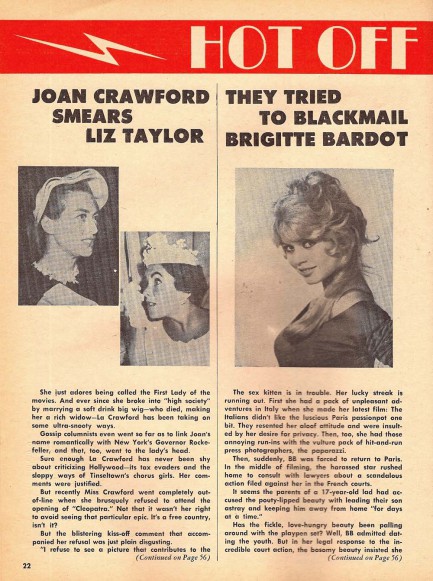 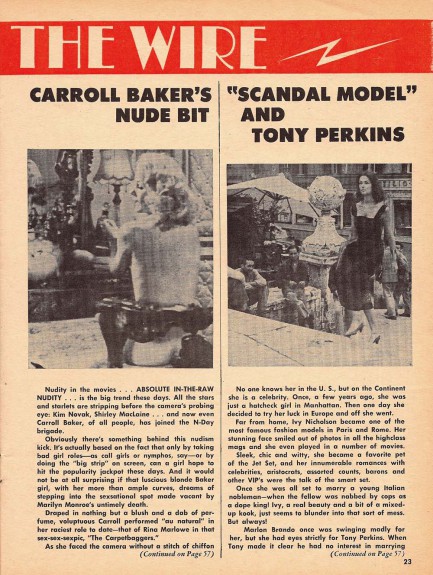 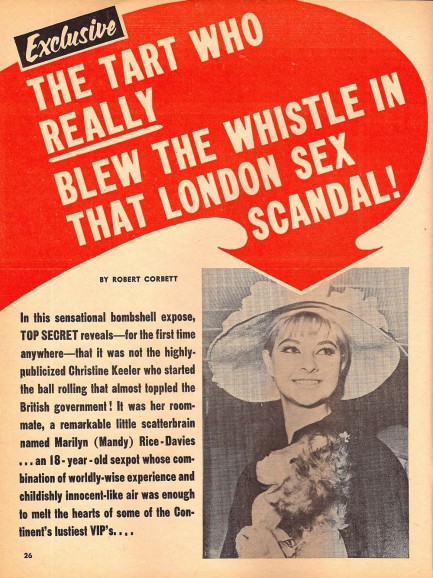 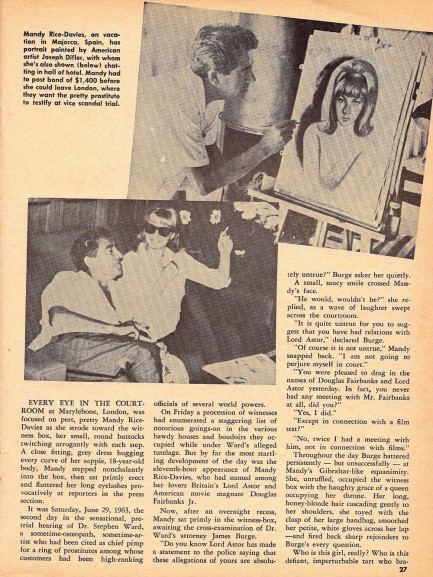 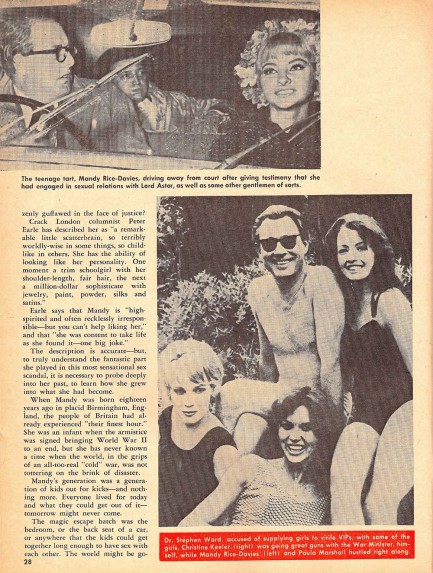 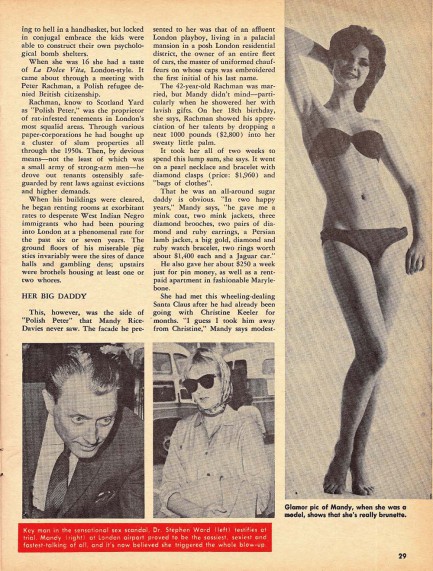 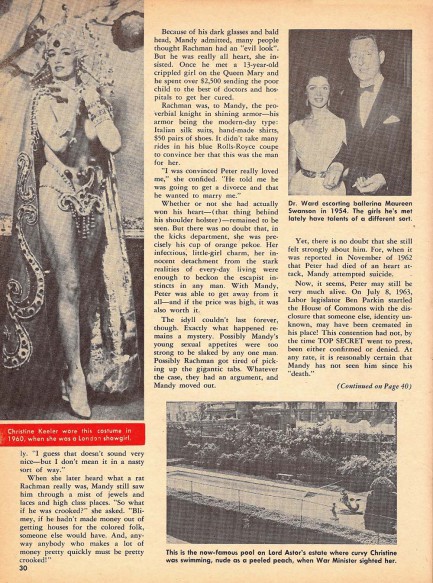 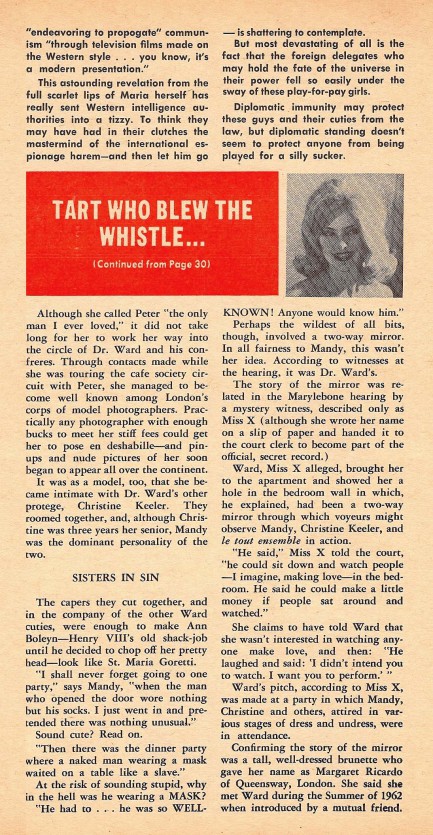 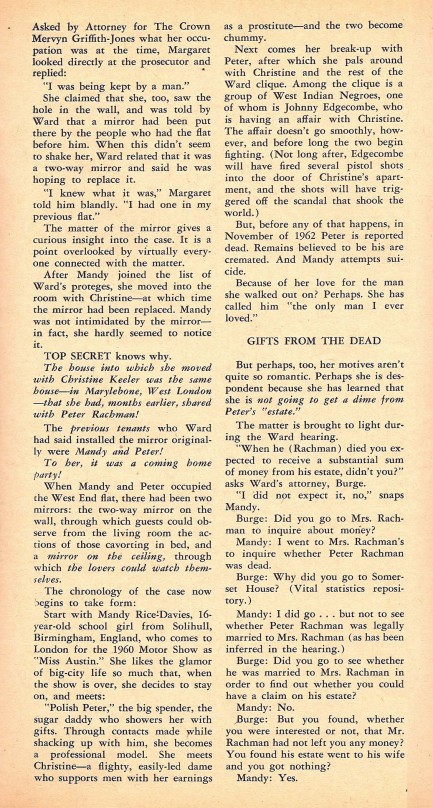 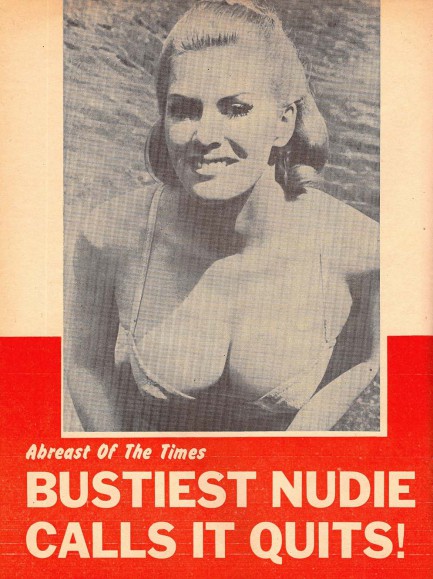 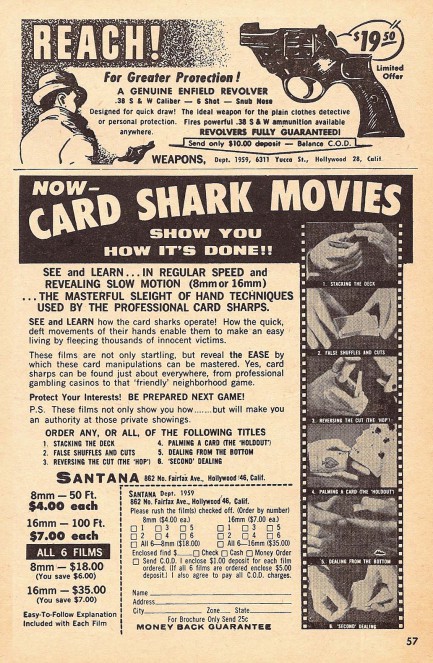
 Sweetie, stop. I said I like sensitive men, but I meant one who puts the toilet seat down. 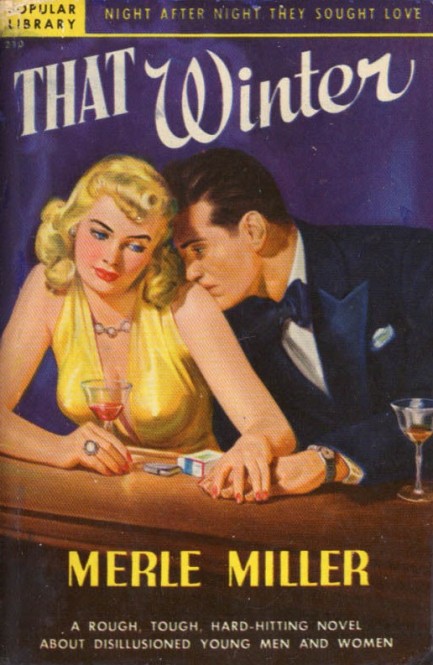
Merle Miller’s That Winter is one of the better post-World War II novels, dealing with the time-honored theme of veterans struggling to fit in after their military service. One has a dead end job, another believes he can function only in the army, and another is trying to hide the fact that he’s Jewish. In the area of feeling forced to hide an essential aspect of oneself, Miller knew exactly what he was writing about. In 1971 at the age of fifty-one, during a time when he was a public intellectual of considerable stature, he came out in the New York Times Magazine as gay. The article catapulted him into the forefront of gay activism, a status he maintained the rest of his life. That Winter was his first novel, appearing in 1948, with the above Popular Library edition hitting shelves in 1950. The great cover art could be by Earle Bergey, but Christopher P. Stephens’ reference tome A Checklist of the Popular Library Paperbacks lists no illustrator, so we’ll have to go with unknown on this one for now.
 Police Gazette reveals the most obvious secret ever. 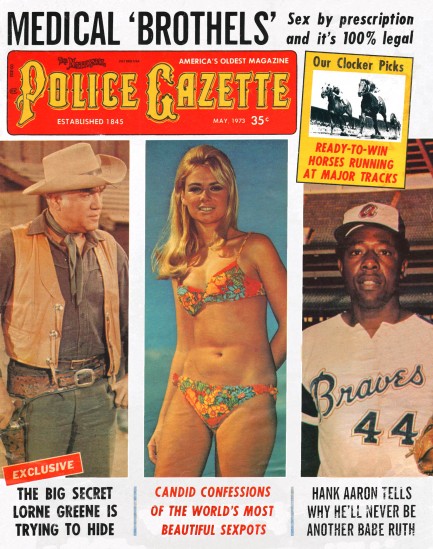
This late stage Police Gazette was published this month in 1973 and features a cover triptych of Lorne Greene, Hank Aaron, and Australian actress Cathy Troutt, aka Kathy Troutt. Gazette claims that Greene planned to run for political office (he didn’t) and ponders whether Aaron can break MLB’s home run record (he obviously did), but we’re interested today in the Troutt story, which isn’t really about her but rather an entire group of female celebs whose secrets Gazette promises to reveal.
What are these mysterious secrets? Well, Vivianne Ventura reveals, “I would never allow myself to fall in love with a poor man.” Minda Feliciano says, “A man will drop everything—his business, his girls, his family—to follow me. I have that effect on men.” Gay Beresford says, “I adore money and luxury and flying to Paris and staying at the Plaza Athenee.” Emma Breeze says, “I prefer luxury.” So it seems the secret, which is no secret at all, is that they love money. Only Cathy/Kathy Troutt seems to feel differently, saying that she wants merely to settle down and have a normal life. Why she’s even with this group of women is perhaps the real mystery, but maybe she was the consolation prize for the Gazette’s decidedly non-glamorous demographic. Today Troutt maintains a very interesting website concerned with ocean diving, marine life and other subjects. You can see it here, and ten scans from the Gazette appear below.   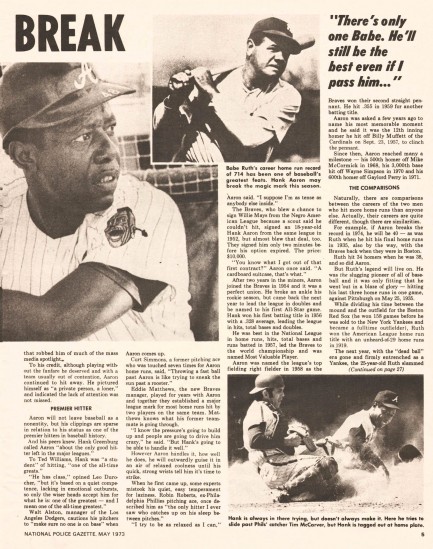 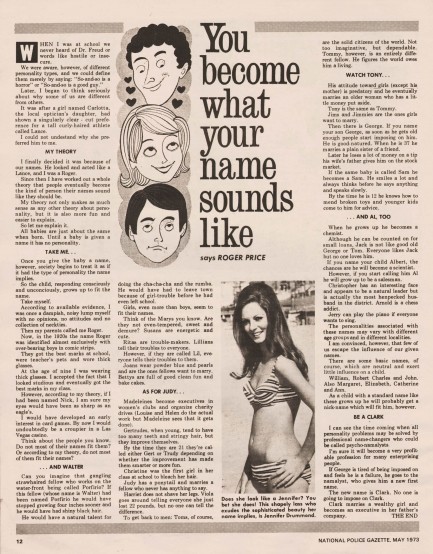 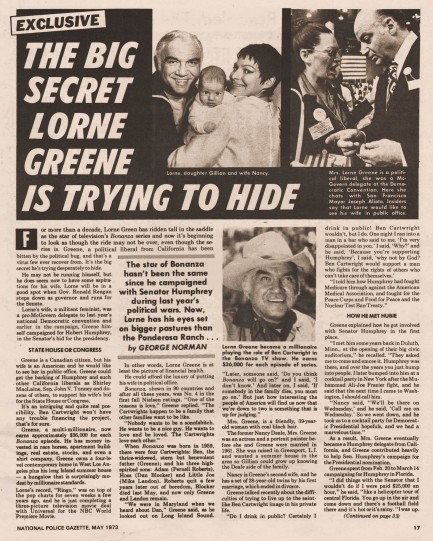 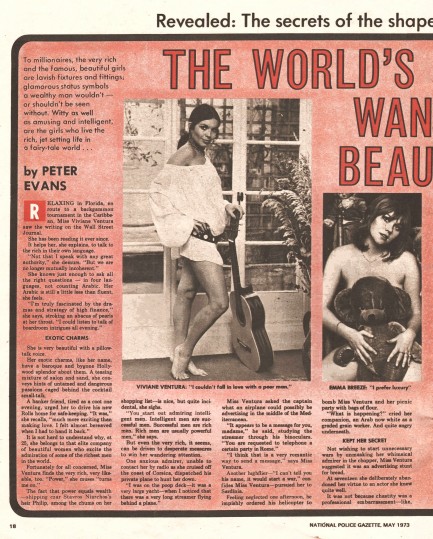 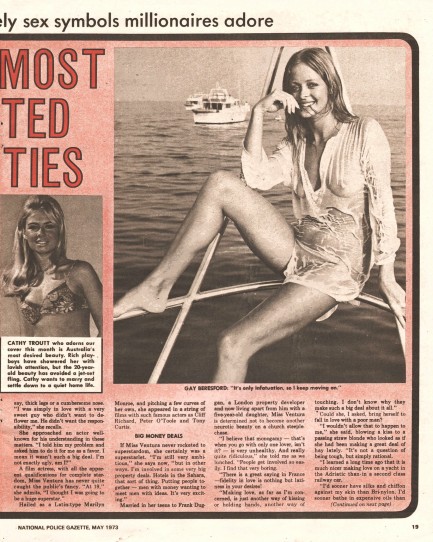 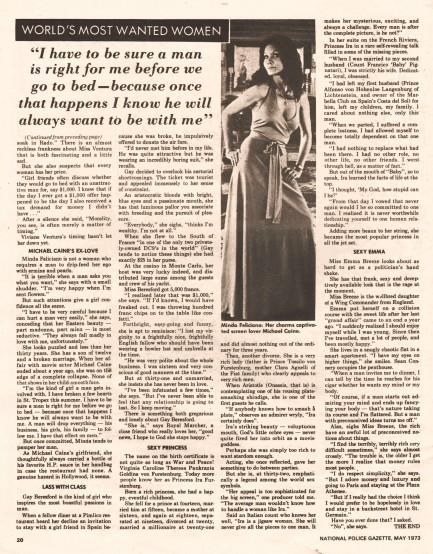 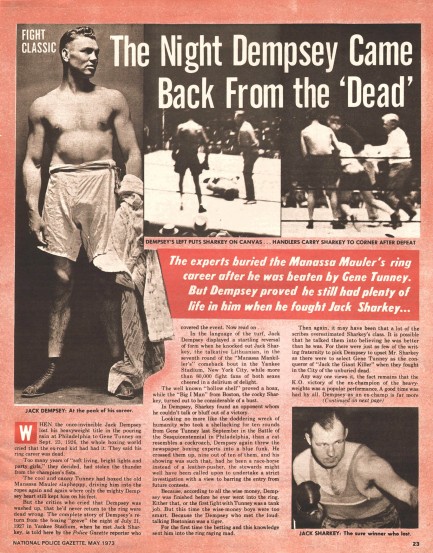 
 Liberace is finally forced to take up arms against the tabloids. 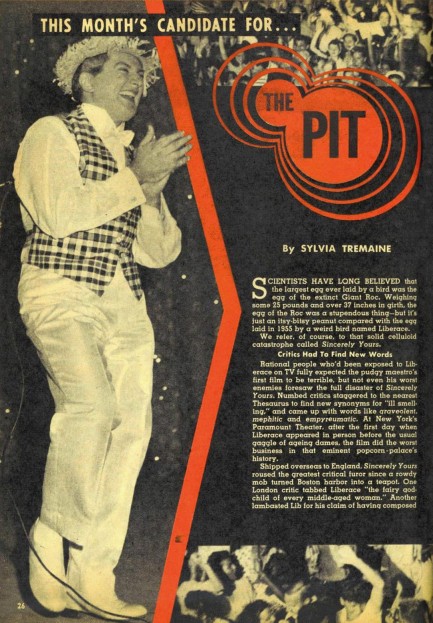 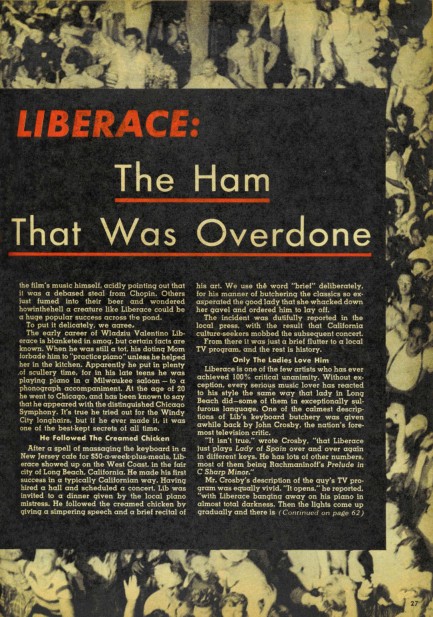
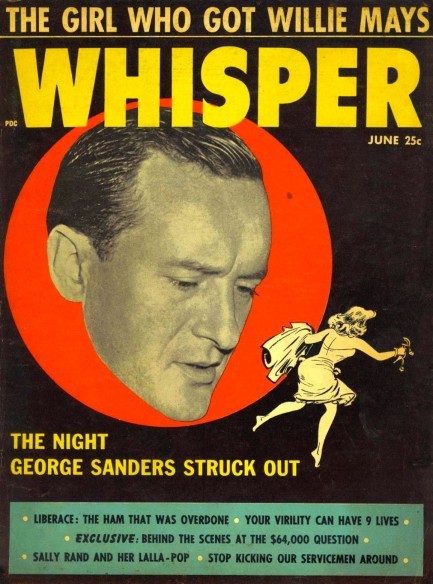 A long while ago we shared the cover of a 1956 Whisper featuring George Sanders. The same issue had an article on Liberace, and we’re returning to that today as part of our look at mid-century tabloid attitudes toward gay culture. In general of course, the tabloids were brutally insulting, using overt as well as coded language to get intimations of homosexuality across. Theoretically, when dealing with public figures they had to be somewhat cautious, but both Rave and Inside had in 1954 written stories insinuating that Liberace was gay, and in 1955 Suppressed and Private Lives did the same. In Whisper, a journalist writing under the name Sylvia Tremaine refers to Liberace as a “creature,” labels his speech as “simpering,” and describes his move to television this way: “From there it was just a brief flutter to a local TV program.” A long while ago we shared the cover of a 1956 Whisper featuring George Sanders. The same issue had an article on Liberace, and we’re returning to that today as part of our look at mid-century tabloid attitudes toward gay culture. In general of course, the tabloids were brutally insulting, using overt as well as coded language to get intimations of homosexuality across. Theoretically, when dealing with public figures they had to be somewhat cautious, but both Rave and Inside had in 1954 written stories insinuating that Liberace was gay, and in 1955 Suppressed and Private Lives did the same. In Whisper, a journalist writing under the name Sylvia Tremaine refers to Liberace as a “creature,” labels his speech as “simpering,” and describes his move to television this way: “From there it was just a brief flutter to a local TV program.”
You’ll notice there’s deniability in all those words—Whisper could claim there was nothing defamatory in the language. Ridiculous, of course. Clearly the magazine was calling Liberace gay, and only a fool would claim otherwise, but defamation had not occurred to an extent that would stand up in court. Thus we see the joy of coded language. The same occurs in the U.S. today in certain media outlets with language directed at African Americans. The disparagement is clear, but deniable. Or for a cinematic example of coding, consider the Maltese Falcon and how the character of Joel Cairo is announced by flute trills on the soundtrack. Clear, and yet deniable. But in its Liberace article Whisper then throws deniability out the window with this: “Hollywood snickerers are wondering, in fact, if all the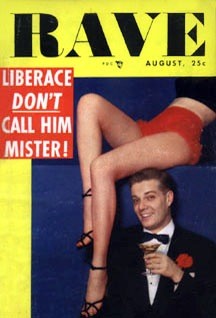 male hormones earmarked for the Liberace boys weren’t hogged by George, leaving Lee with only his nimble fingers.” That goes a bit beyond code, wouldn’t you say? male hormones earmarked for the Liberace boys weren’t hogged by George, leaving Lee with only his nimble fingers.” That goes a bit beyond code, wouldn’t you say? Liberace did not sue, and the tabloids simply built momentum. Later in 1956 Britain’s Daily Mirror called him a “deadly, winking, sniggering, snuggling, chromium-plated, scent-impregnated, luminous, quivering, giggling, fruit-flavoured, mincing, ice-covered heap of mother love.” Robert Harrison’s Confidential piled on in 1957. It published a three-part tale of Liberace attacking a hapless press agent. A sample from that hit piece: “Fatso plumped onto the couch alongside his young guest, and before you could say Gorgeous George, the pair were [wrestling]. In a matter of moments, it turned into a boxing bout, too, with the press agent throwing desperate lefts and rights at Liberace. The latter, his determination stiffening, merely clung tighter. The floor show reached its climax when Dimples, by sheer weight, pinned his victim’s shoulders to the mat and mewed into his face: 'Gee, you’re cute when you’re mad!'”
Liberace’s lawyer John Jacobs filed lawsuits against both Daily Mirror and Confidential, demanding a whopping twenty million dollars from the latter. Adjusted for inflation, that's about $174 million in today's terms. You can almost imagine Robert Harrison spitting up his coffee when he heard the settlement demand. Equally you can imagine Liberace’s reluctance to dignify the article, but Confidential at the time had readership in the millions. Something had to be done. It had become open season on his private life. Even the press photo below toyed with him. The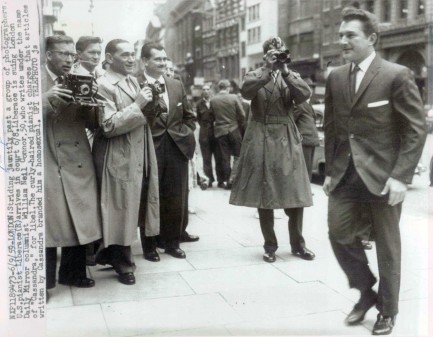 descriptive text, written for newspaper staff, is meant to simply get across the basic facts of the photos and is typically pretty dry stuff. But this describes Liberace as "the curly-haired pianist" and says his walk is "jaunty." Clear, but deniable. descriptive text, written for newspaper staff, is meant to simply get across the basic facts of the photos and is typically pretty dry stuff. But this describes Liberace as "the curly-haired pianist" and says his walk is "jaunty." Clear, but deniable. In the end, Liberace received $40,000 from Confidential and $53,000 from the Daily Mirror, substantial sums for the time. In addition to his legal victories, the constraints against tabloid journalism were becoming more defined. Of course, Liberace had won the cases by perjuring himself in court about being gay. In 1987 when he died of complications related to AIDS, Daily Mirror refused to show an iota of deference or respect and published a piece referring to the 1950s settlement. It was headlined: Any Chance of a Refund?
 Confidential goes full throttle on the high seas. 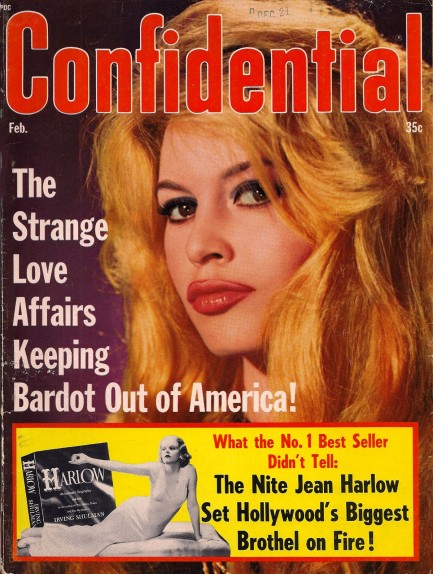
On this Confidential from February 1965 the publishers give their cut-and-paste artists a month off and grace the cover with a simple portrait of Brigitte Bardot and her famed pout. Inside the editors air out her love life in a way that today would be called slut shaming—pretty much stock-in-trade for Confidential. The suggestion is she won’t come to the U.S. to act because she’s busy Morockin’ around the clock with Moroccan-born producer Bob Zaguri. Elsewhere in the issue you get Romy Schneider, Jean Harlow, Alain Delon, Peter O’Toole, love behind the Iron Curtain, and an outraged report on pharmaceutical companies marking up medicines 200%, 500%, even 7,000%. Yes, medicines cost too much in the U.S. even back then. But don’t take our word for it. Take Confidential’s—their story ends by declaring that drug companies have Americans by the balls and the only way to avoid the drug price racket is to not get sick. But moving on, as we mentioned last week, we wanted to look at tabloid attitudes toward gay culture, and this issue has two articles along those lines. The first involves gay cruises off the Florida coast, an activity Confidential informs readers was devised as a way to avoid Dade County vice cops. Once the boats were in international waters there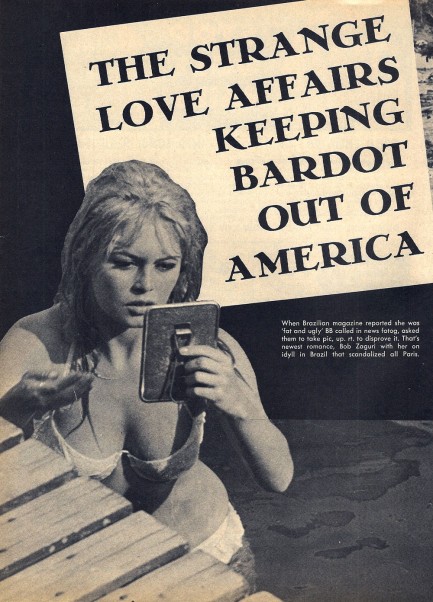 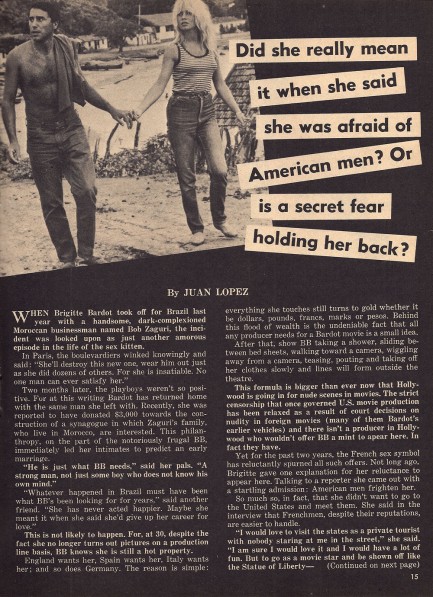 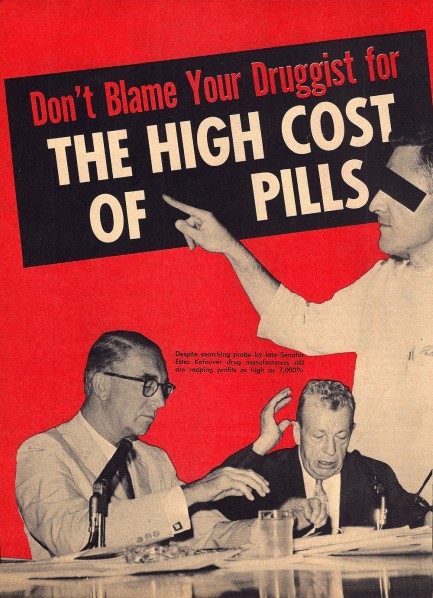 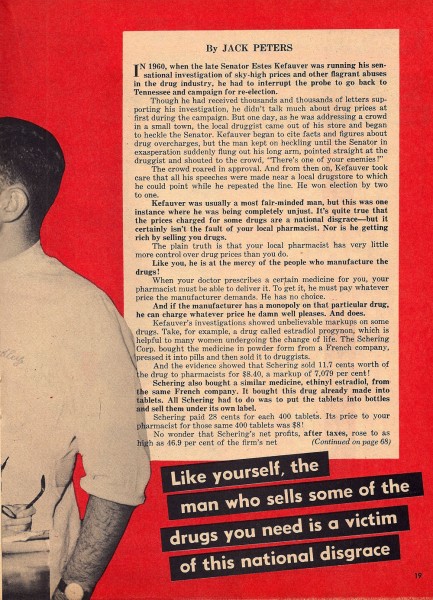 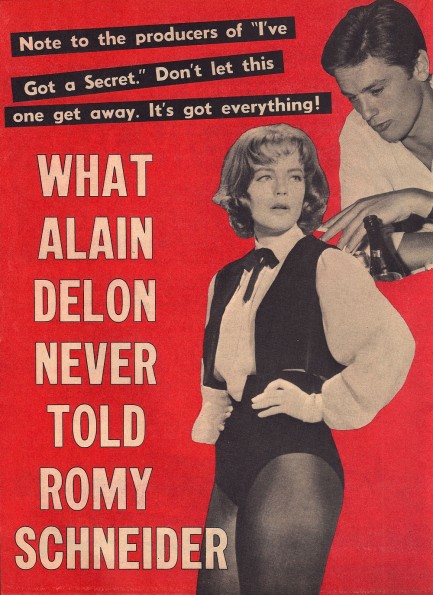 was no law, local or federal, which could be applied against shipboard activities. We’ll come back to that in a sec. The other story involves what Confidential describes as the middlesex—i.e. people who lack strong masculine or feminine characteristics. The story is concerned with this only as a social issue and makes no mention of physically intersex persons who genetically are neither male nor female. was no law, local or federal, which could be applied against shipboard activities. We’ll come back to that in a sec. The other story involves what Confidential describes as the middlesex—i.e. people who lack strong masculine or feminine characteristics. The story is concerned with this only as a social issue and makes no mention of physically intersex persons who genetically are neither male nor female. For Confidential the issue is simple—men are no longer macho enough and women are no longer (submissively) alluring enough. Of course, gay men are the ultimate villains here, and to make the topic emotional for readers Confidential paints a picture of an America devoid of Jayne Mansfields and Lana Turners. The article’s author Harold Cimoli sums it up this way: “As female busts and hips grow ever narrower even Playboy may have trouble keeping its broad-watchers supplied with bosomy playmates.” And there’s also this tidbit: “Designers of both types of clothing are poaching unforgivably on the styles of each other. The main hope must be the evolution of an entirely new style of ensemble for these new phenomena and a new branch of the industry to supply it.” Were they really this comically worried about visual identification issues? Of course they were—what could be more disturbing to guardians of a prevailing social structure than people managing to wriggle out of their pre-assigned boxes? The story on gay cruises is a bit more typical of mid-century tabloids—it’s just a takedown piece. Gay men are blithely described as “lavender lads,” “minces,” and other words we wouldn’t dare dirty our website with. The effusiveness of the magazine’s hateful and sneerful terminology suggests 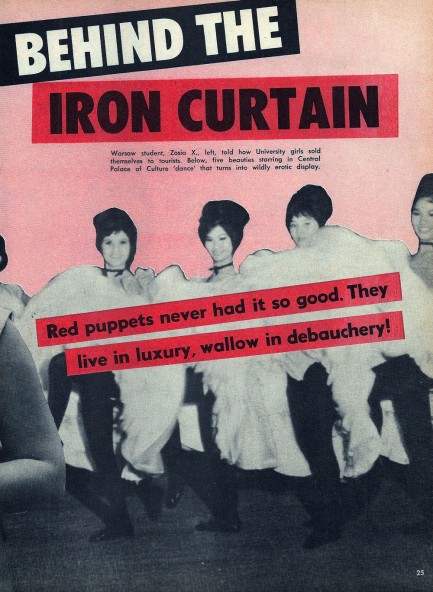 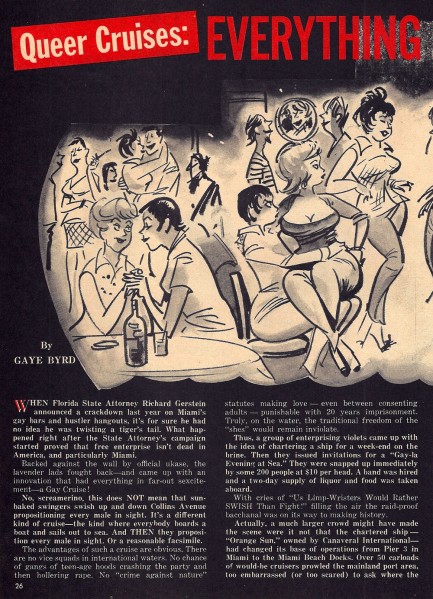  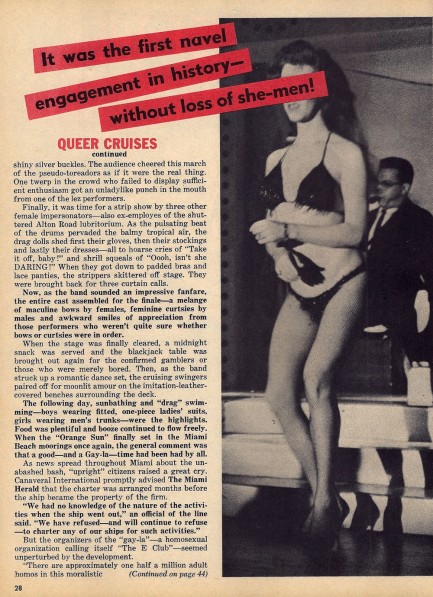 just how certain Confidential editors were that homosexuality was completely beyond the pale. And yet, nearly every issue harped on the subject, either directly or indirectly. For instance, here we get full reportage on a maritime cabaret show featuring drag queens, followed by detailed descriptions of music, dancing, and gambling. You’d almost think the writer Gaye Bird—nice, right?—was actually there. just how certain Confidential editors were that homosexuality was completely beyond the pale. And yet, nearly every issue harped on the subject, either directly or indirectly. For instance, here we get full reportage on a maritime cabaret show featuring drag queens, followed by detailed descriptions of music, dancing, and gambling. You’d almost think the writer Gaye Bird—nice, right?—was actually there. The cruise is eventually reported to the boat rental agency in Miami, whose owner vows that he will never again allow his vessels to be used for such debauchery. The response from the organizer of the cruises was this: “There are approximately one-hundred thousand boats or ships of some sort or another. I think we’ll be able to find some way to balance supply and demand.” Ouch—zinged right in the Econ 101s. Doubtless Confidential expected the congressional switchboard to light up over this outrageous appropriation of boats meant for exclusively heterosexual usage, but whether it happened we can’t say—the story ends there. And Confidential readers were left to endure thirty days of disquiet until the next gay bashing issue came out. We won't wait quite that long—we'll explore this subject in another tabloid soon. More scans below.
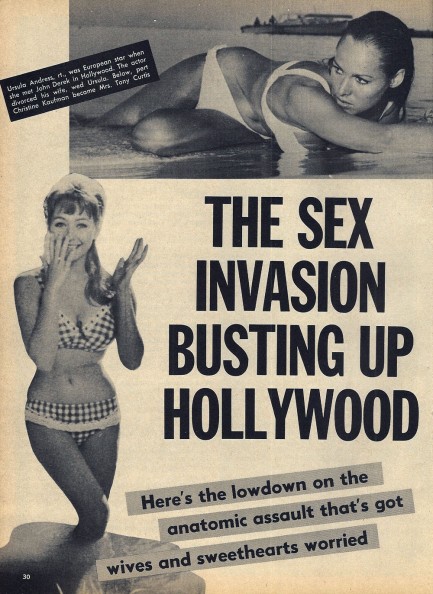 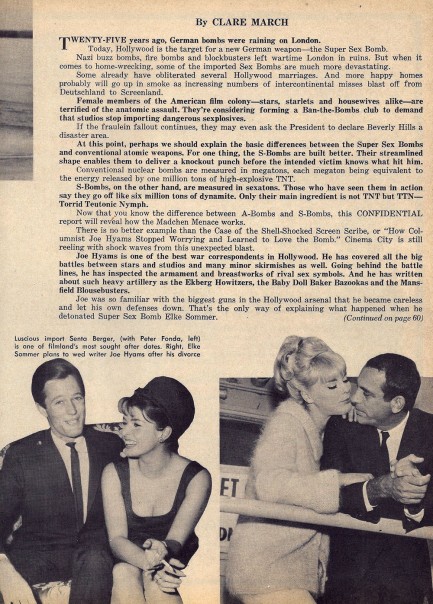 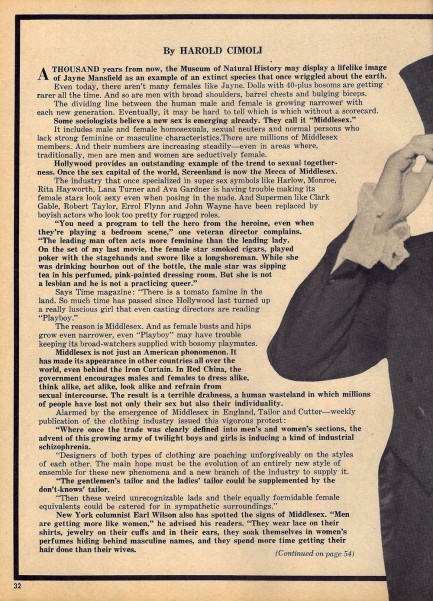  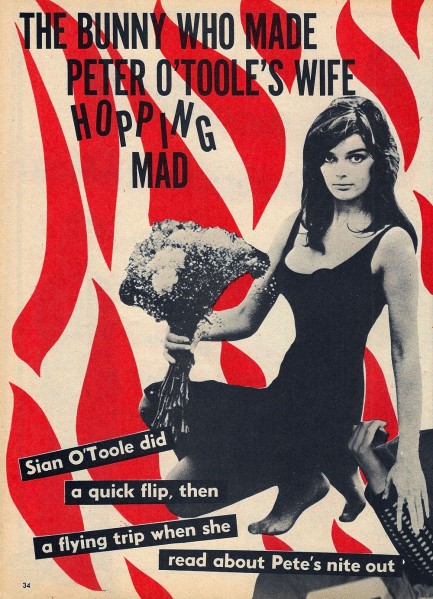 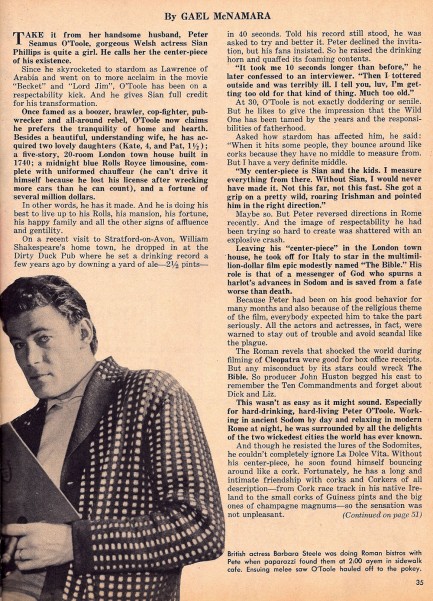 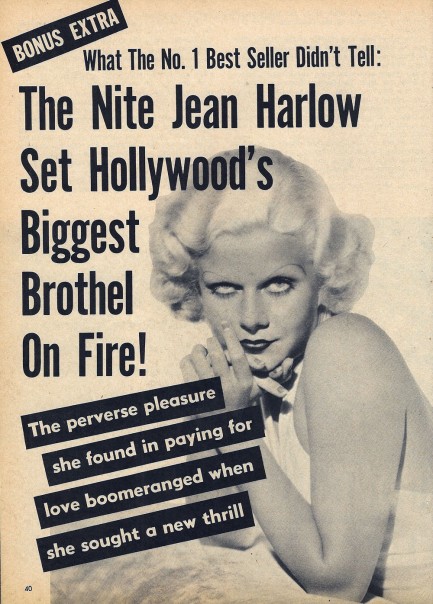 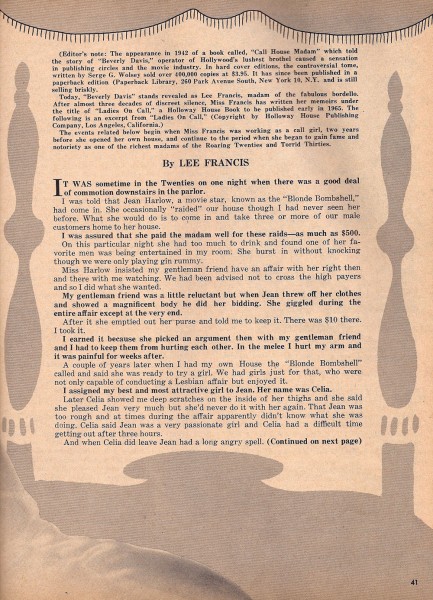
 Even in decline Confidential had eyes and ears everywhere. 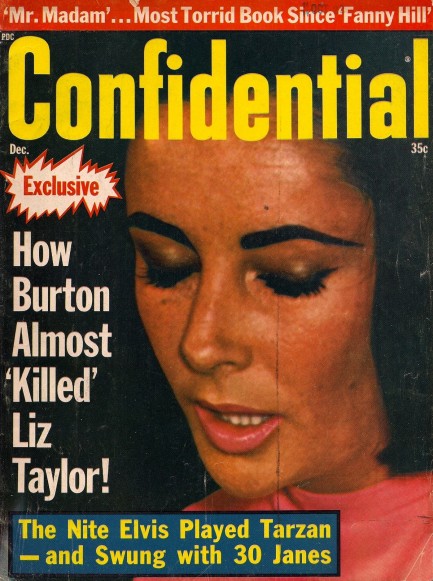
Liz Taylor and her tan star on this cover of Confidential published this month in 1964. The magazine was just a shadow of its former self by this point, but the inside stories still manage to raise eyebrows and give the impression of tabloid spies in every corner of Hollywood. Simon Lee Garth’s exposé accuses Richard Burton of being an abusive drunk, but that was not a scoop—other tabloids had written the same. But elsewhere, investigative journo Beverly Hillis (nice, right?) shares the amusing story of Elvis Presley throwing a party at which only women were invited. Apparently “swivel hips”, as Confidential refers to him, paraded around in a series of bizarre costumes and generally acted the fool, prompting some (but crucially not all) of his guests to leave in a huff. In another story Jack Asher writes about bottomless swimsuits worn by gay men as a response to the topless women’s suits that had appeared on European beaches, and also tells readers the fashion house Lanvin Paris had begun selling a bottomless suit for women. We don’t buy that one for a minute, but there are some interesting photos of women wearing breast-baring dresses. Elsewhere in the issue you get tabloid fave Jayne Mansfield and her husband Mickey Targitay, Peter Sellers sexing himself into a heart attack with Britt Ekland, Barry Goldwater playing dirty politics, and an impressively tasteless graphic of Malcolm X. All below.
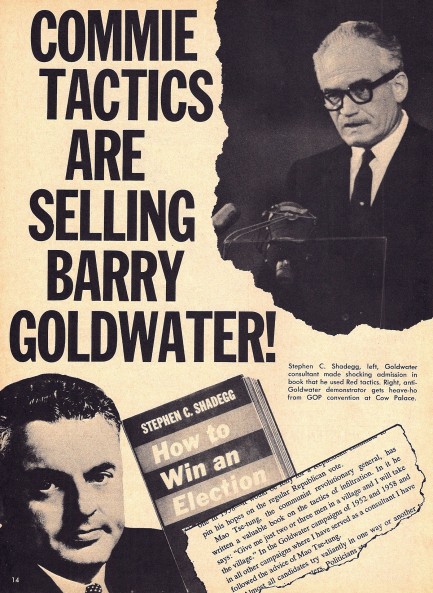 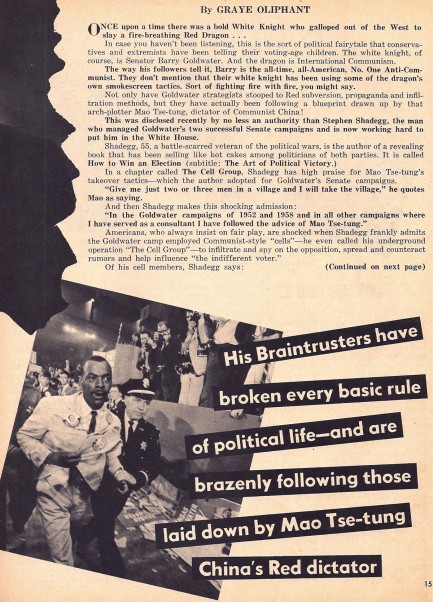  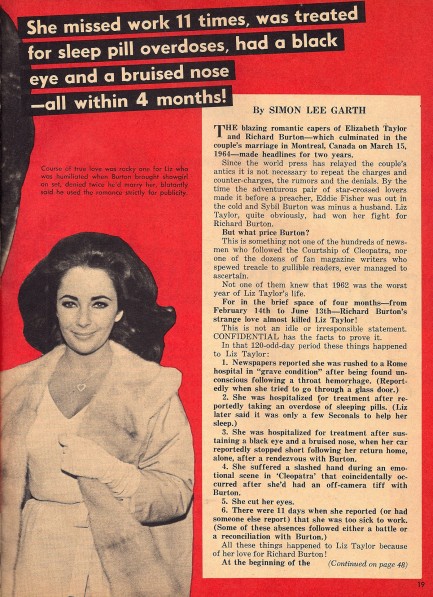 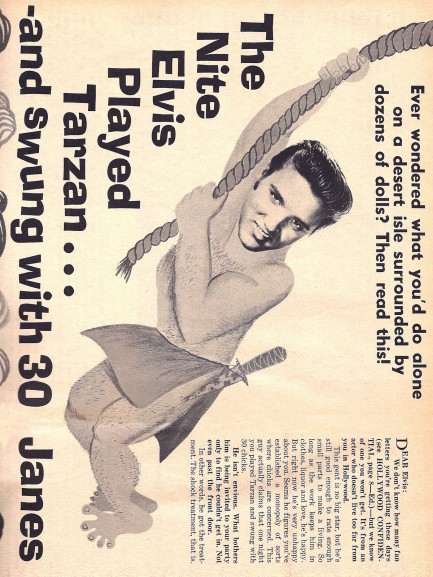 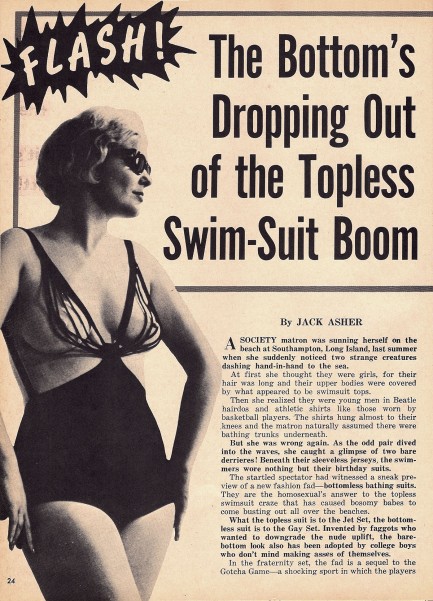 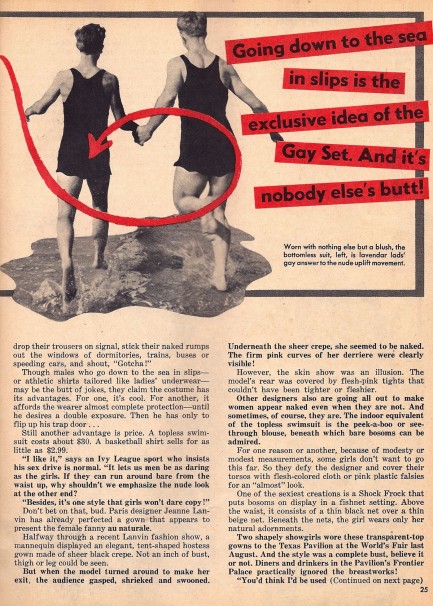 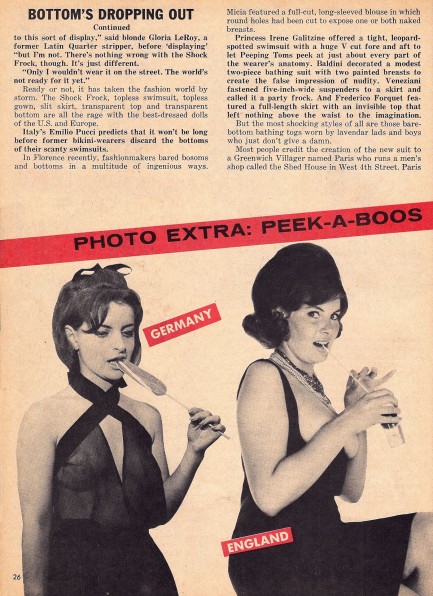 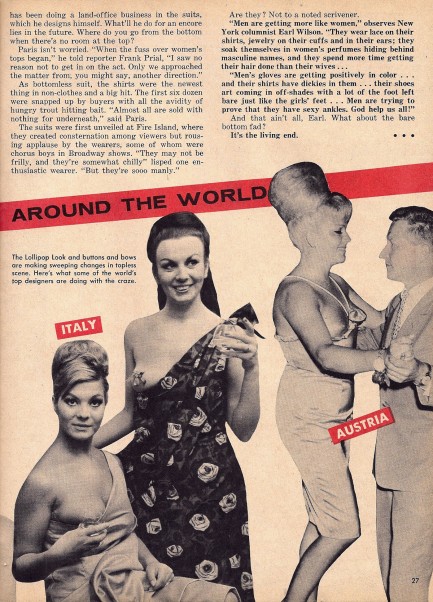 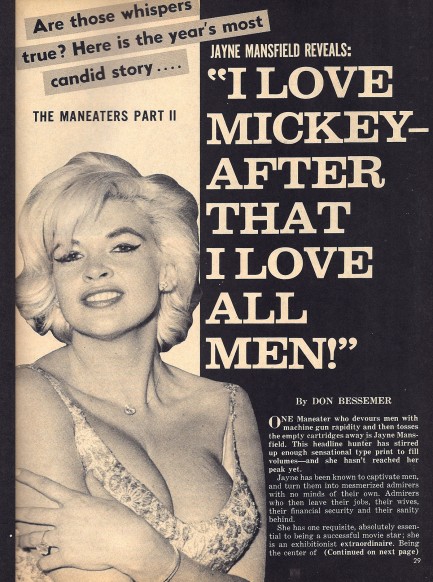 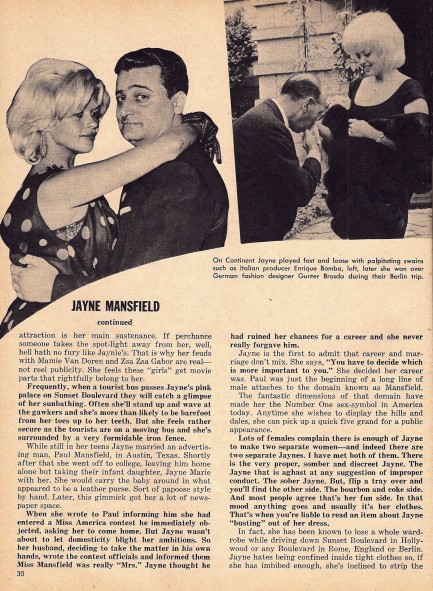  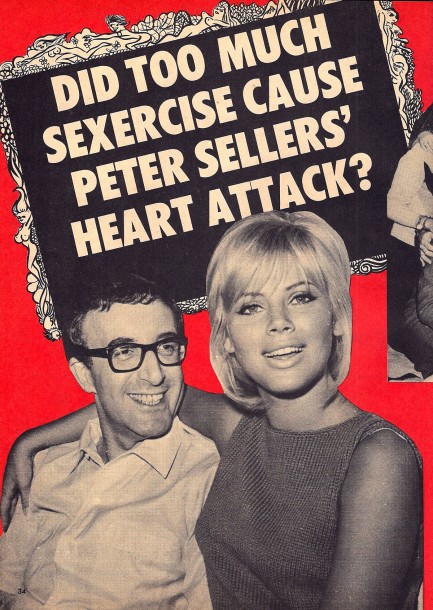 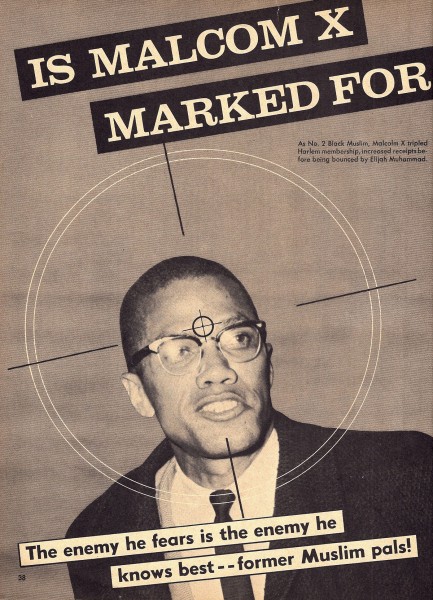 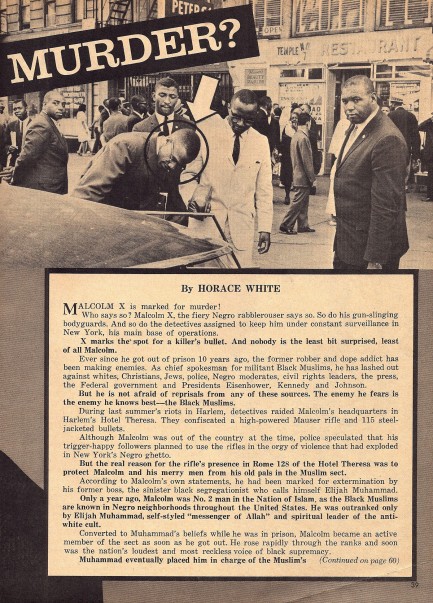 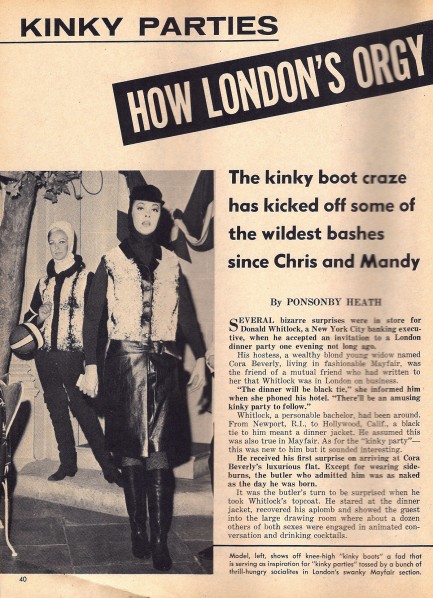  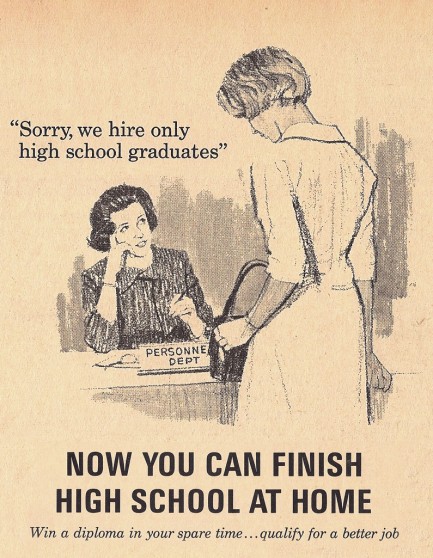
 The Lowdown proves that it deserves its name. 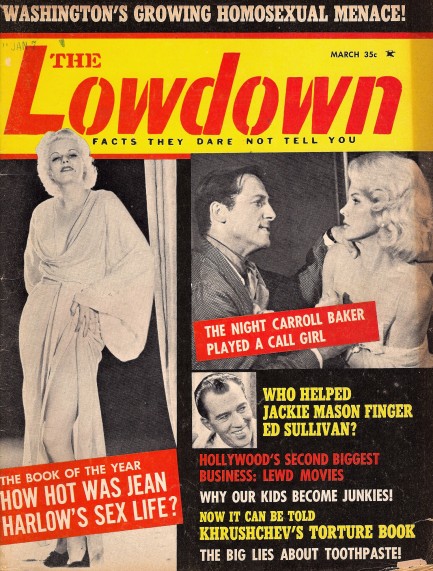
We’re jumping right into our treasure trove of newly arrived tabloids today with a glance at this issue of The Lowdown published in March 1965. On the cover you see Jean Harlow, Carroll Baker, and Ed Sullivan. We talked about Baker recently and there she is in that crazy gown again (below)—or is she? No, on close examination this is yet another version of the dress. Clearly, the photo was shot on a different night than all the others because her hair and jewelry are different. But the actual dress also looks slightly different from both the Oleg Cassini and Pierre Balmain iterations. A reference in the story clears things up at least a little: “Transparency gowns are another of her big passions and she often wears them.” There you have it. Half naked was a fairly standard look for Carroll Baker. They just don’t make stars like they used to.
You might be curious what the article is about. On the cover the header reads: “The Night Carroll Baker Played a Call Girl,” but on the inside, it says: “The Night Carroll Baker Played a Harlot!” The story goes that she wanted to research her role as a prostitute in the movie Sylvia, so she 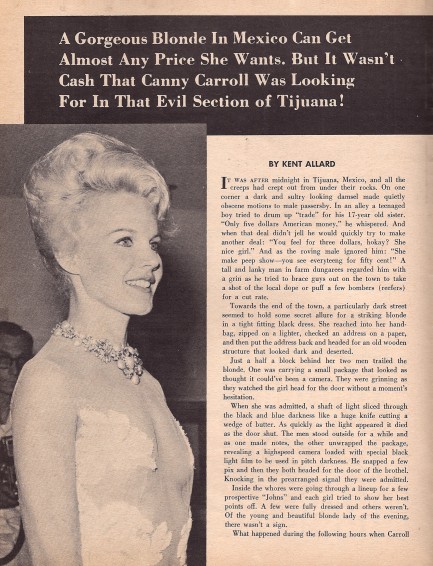 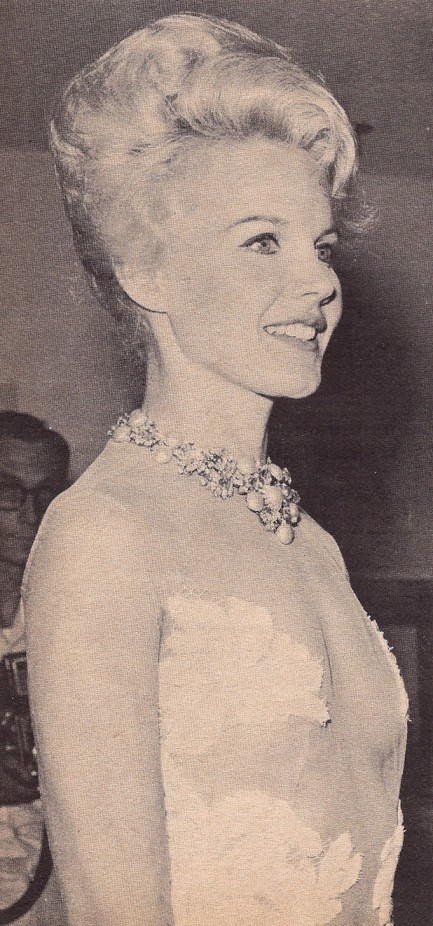 ventured down to Tijuana, Mexico, toured a few brothels, and somehow disappeared alone for two hours: “We don’t know what happened in the house in Mexico or what sights she could have barged in on, but that is bouncy Miss Baker’s bit.” Lost in a Mexican whorehouse. The mind reels. Do we buy it? Not for a minute. ventured down to Tijuana, Mexico, toured a few brothels, and somehow disappeared alone for two hours: “We don’t know what happened in the house in Mexico or what sights she could have barged in on, but that is bouncy Miss Baker’s bit.” Lost in a Mexican whorehouse. The mind reels. Do we buy it? Not for a minute. The other story of note asks: “How Hot Was Jean Harlow’s Sex Life?” Well, let's take an up close look and find out. In 1932 when Harlow was 21 years old she married Paul Bern, a director and screenwriter. Bern apparently had never done well in the sex department due entirely to his own lack of passion, and his shyness was well known. To him Harlow supposedly represented a chance at true sexual fulfillment. If the most desired woman in Hollywood couldn’t rouse his slumbering libido, nobody could. According to The Lowdown, Bern failed on the wedding night. Here’s what the text says: In the wee hours of the morning, Jean’s agent [Arthur] Landau received a frantic call from her asking that he come and get her immediately. When [they] got to Landau’s home, according to the agent, Jean stripped off her filmy wedding nightgown to reveal her beautiful body a mass of welts and bruises. “Her back and buttocks were covered with bruises. There 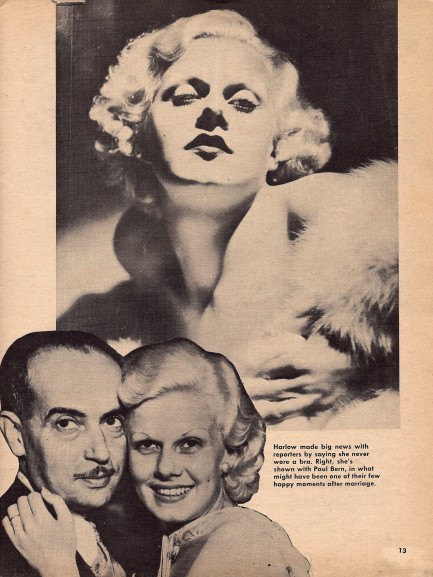 was one especially bad bruise directly over her kidneys.” The implication here is because Harlow died several years later of kidney failure that she incurred the fatal damage during that wedding night beating. It gets weirder—brace yourselves. Landau goes to Paul Bern’s house, geared for a confrontation: was one especially bad bruise directly over her kidneys.” The implication here is because Harlow died several years later of kidney failure that she incurred the fatal damage during that wedding night beating. It gets weirder—brace yourselves. Landau goes to Paul Bern’s house, geared for a confrontation: The bridegroom of some eleven hours was [snip] sprawled nude and drunk on the floor of his den. Silently hating the man at his feet, Landau wanted to kick the slight, pasty body of Bern. Instead he rolled the unconscious man to his back to discover what had never been suspected by anybody in the industry. Paul Bern had the sack and penis of an infant boy. The story goes on to explain that the entire mess was hushed up for the sake of Harlow’s career. Two months later Bern committed suicide via a bullet through the brain. One more excerpt: Paul had prepared himself for death by removing all his clothing and stood before the dressing room mirror. [snip] And, staring at his tormented body, he pulled the trigger. The nudity added a sexual element to his suicide that encouraged a spectrum of interpretations of his farewell note: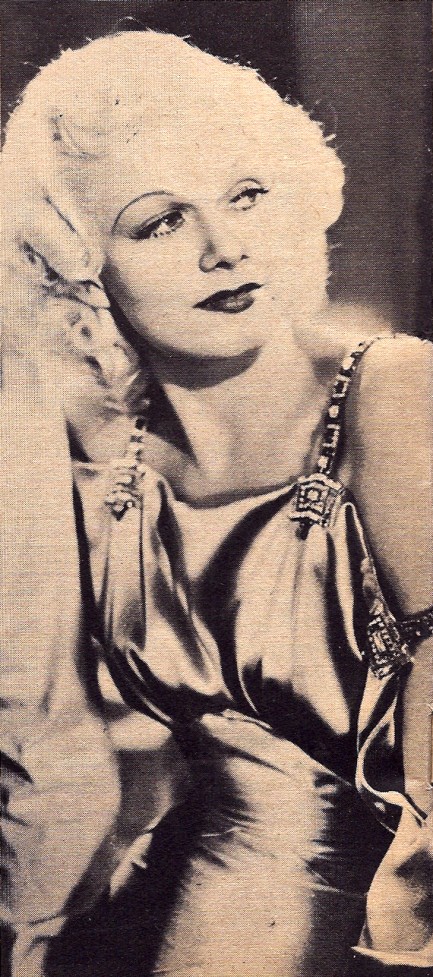 “Dearest dear, unfortunately this is the only way to make good the frightful wrong I have done to you and to wipe out my abject humiliation. I love you. Paul.
You understand that last night was only a comedy.” What was the comedy? Harlow said nothing to the press. But according to Arthur Landau, she told him Paul Bern had spent $200 on a device to increase his manhood. Wearing the contraption he had entered their bedroom intent on finally consummating their marriage. This hope was doomed from the start and the whole plan turned into such a tragic farce that both he and Jean finally gave way to hysterical laughter. That’s probably one of the sadder stories you’ll ever hear. Is it true? It appeared in a biography about Harlow, but we can never know. We can, however, at least answer the question posed by The Lowdown’s story header. No—Jean Harlow’s sex life was not hot at all.
 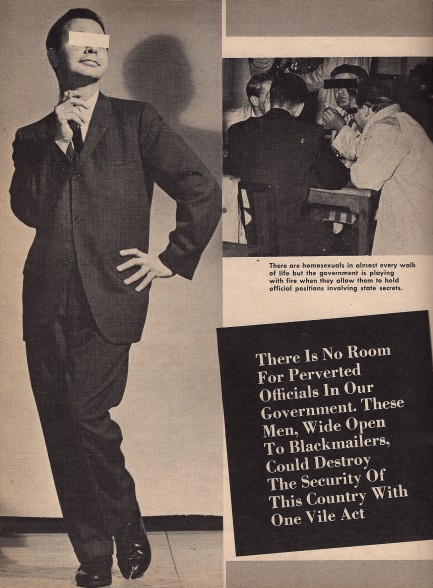 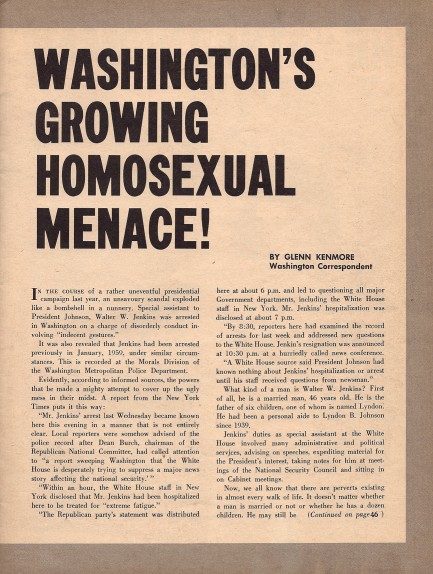 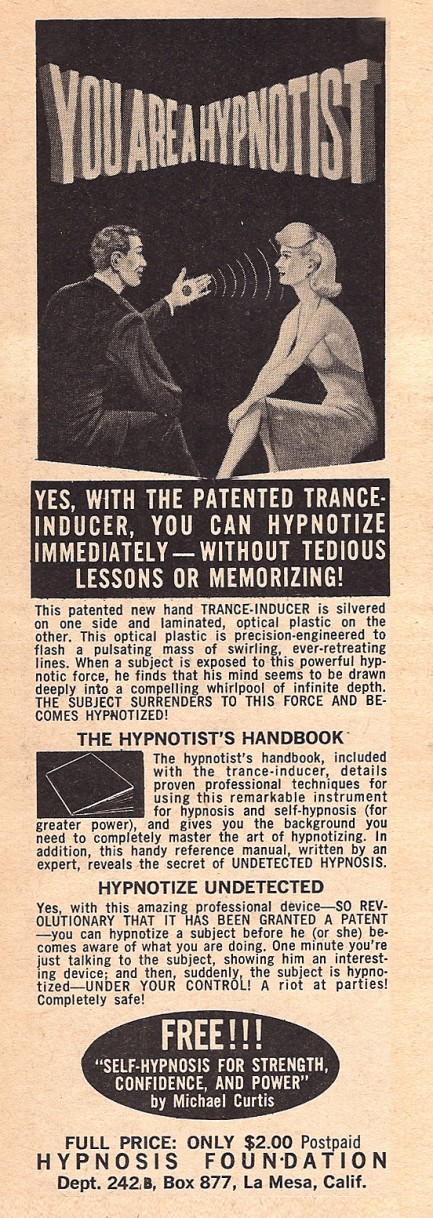 
 The young and the restless. 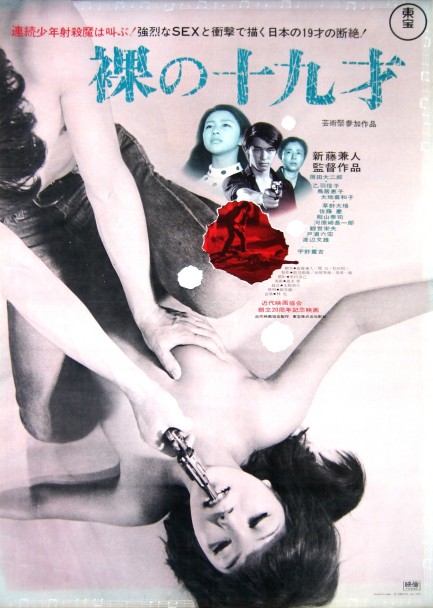
The Japanese crime drama Hadaka no Jukyu-sai, aka Live Today, Die Tomorrow, is the tale of an 18-year old country boy named Michio who is relocated to Tokyo for a work program and quickly rebels against the authoritarians around him. After going off the reservation he drifts into petty crime, which in turn leads to a shooting spree during which he murders several people. The movie seems to be critical of both Japanese city life and American influence (Michio acquires the gun by stealing it from an American), and we found it to be an interesting and engrossing fable. Later, we realized that the film was probably inspired by the real-life story of Norio Nagayama, a 19-year old who in 1969 shot four people dead with a gun he acquired from a U.S. military base. He was caught, tried, convicted, and sentenced to death. He had been in jail for about eighteen months when Hadaka no Jukyu-sai hit cinemas.
No word on whether Nagayama saw it, but for some reason he was inspired to write, and by 1971 he was being published. He eventually wrote six books (with the profits going to compensate his victims’ families), and garnered critical acclaim as well as winning the New Japan Literary Award in 1984. After years of appeals and stays, Nagayama was executed in August 1997 and his ashes scattered in the sea. The movie he inspired is worth a look if you can find it anywhere, and the poster art is, well, killer. Hadaka no Jukyu-sai premiered in Japan today in 1970.
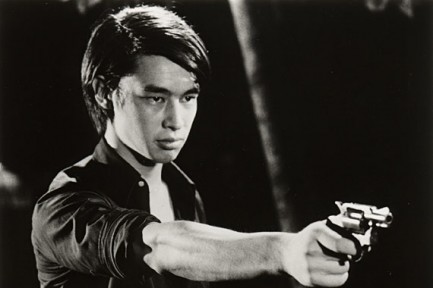
 |  |
|
 |

The headlines that mattered yesteryear.
1933—The Gestapo Is Formed
The Geheime Staatspolizei, aka Gestapo, the official secret police force of Nazi Germany, is established. It begins under the administration of SS leader Heinrich Himmler in his position as Chief of German Police, but by 1939 is administered by the Reichssicherheitshauptamt, or Reich Main Security Office, and is a feared entity in every corner of Germany and beyond. 1937—Guernica Is Bombed
In Spain during the Spanish Civil War, the Basque town of Guernica is bombed by the German Luftwaffe, resulting in widespread destruction and casualties. The Basque government reports 1,654 people killed, while later research suggests far fewer deaths, but regardless, Guernica is viewed as an example of terror bombing and other countries learn that Nazi Germany is committed to that tactic. The bombing also becomes inspiration for Pablo Picasso, resulting in a protest painting that is not only his most famous work, but one the most important pieces of art ever produced. 1939—Batman Debuts
In Detective Comics #27, DC Comics publishes its second major superhero, Batman, who becomes one of the most popular comic book characters of all time, and then a popular camp television series starring Adam West, and lastly a multi-million dollar movie franchise starring Michael Keaton, then George Clooney, and finally Christian Bale. 1953—Crick and Watson Publish DNA Results
British scientists James D Watson and Francis Crick publish an article detailing their discovery of the existence and structure of deoxyribonucleic acid, or DNA, in Nature magazine. Their findings answer one of the oldest and most fundamental questions of biology, that of how living things reproduce themselves. 1967—First Space Program Casualty Occurs
Soviet cosmonaut Vladimir Komarov dies in Soyuz 1 when, during re-entry into Earth's atmosphere after more than ten successful orbits, the capsule's main parachute fails to deploy properly, and the backup chute becomes entangled in the first. The capsule's descent is slowed, but it still hits the ground at about 90 mph, at which point it bursts into flames. Komarov is the first human to die during a space mission.
|

|
|

It's easy. We have an uploader that makes it a snap. Use it to submit your art, text, header, and subhead. Your post can be funny, serious, or anything in between, as long as it's vintage pulp. You'll get a byline and experience the fleeting pride of free authorship. We'll edit your post for typos, but the rest is up to you. Click here to give us your best shot.

|
|









 story begins with the tale of a company president who unknowingly hired a gay man and had no idea until several years later when the hiree—now a manager—got drunk at a company party and began slapping and scratching another man. Soon four employees were involved in this spat. The company president exclaimed: “My God! Those men are all queers!”
story begins with the tale of a company president who unknowingly hired a gay man and had no idea until several years later when the hiree—now a manager—got drunk at a company party and began slapping and scratching another man. Soon four employees were involved in this spat. The company president exclaimed: “My God! Those men are all queers!”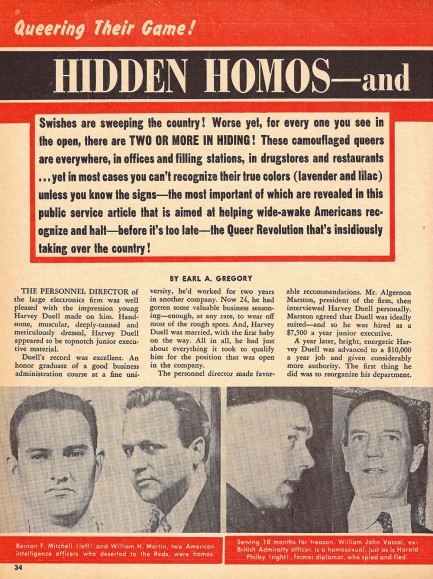
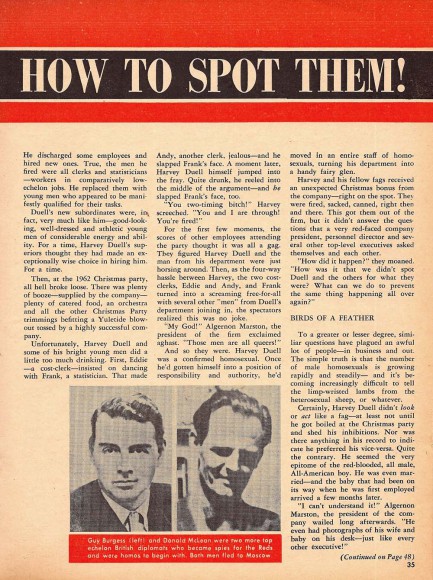














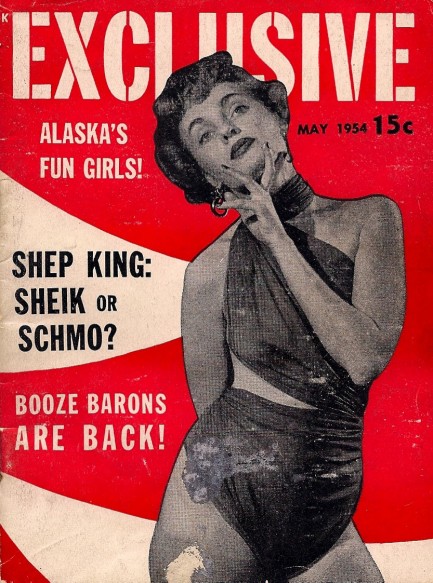
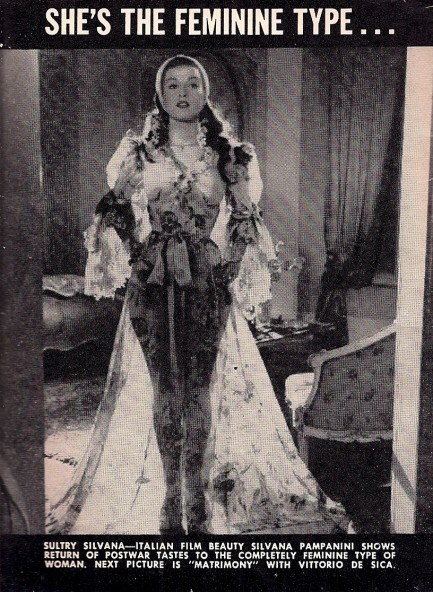

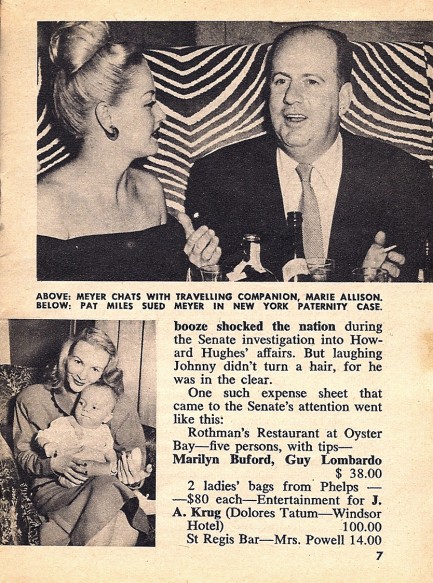
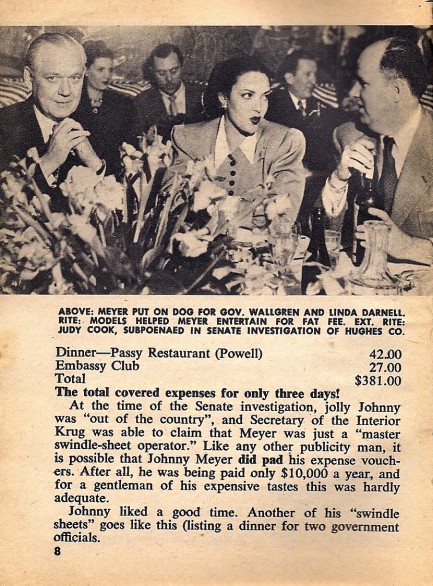
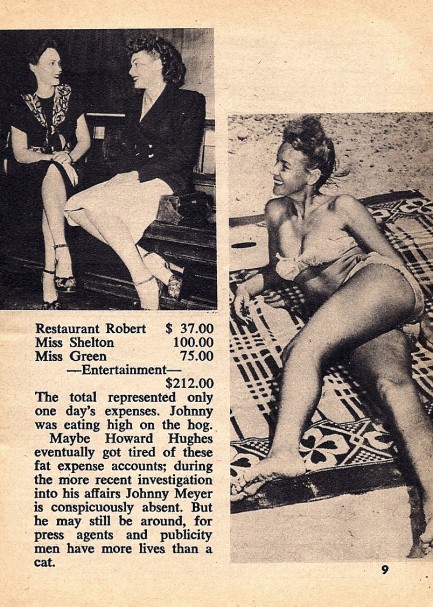
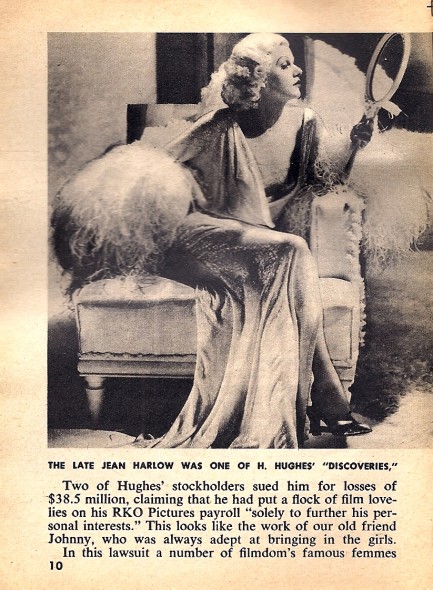
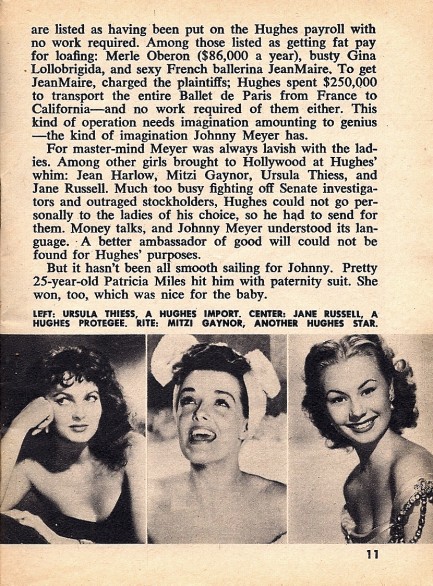

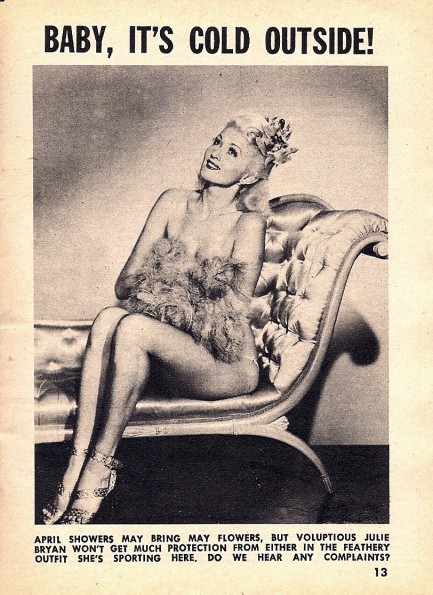

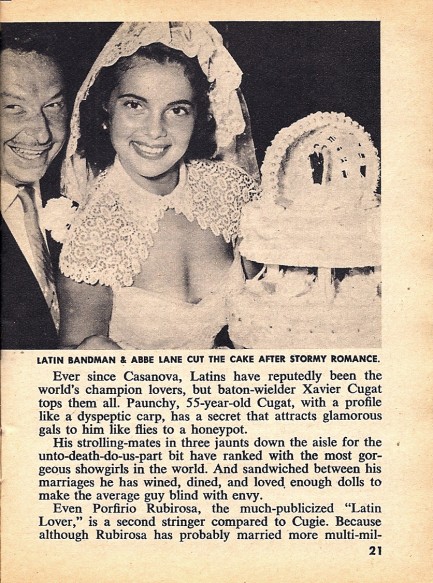
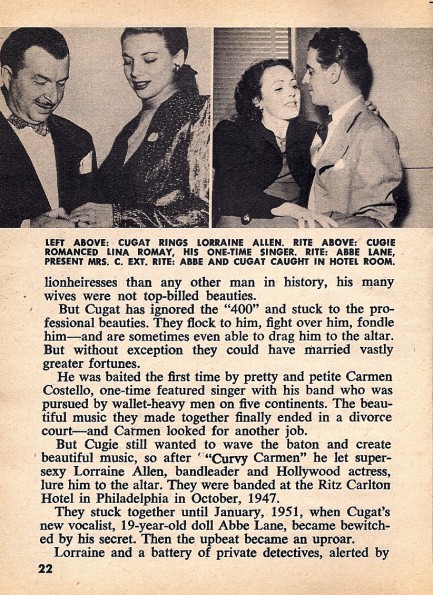
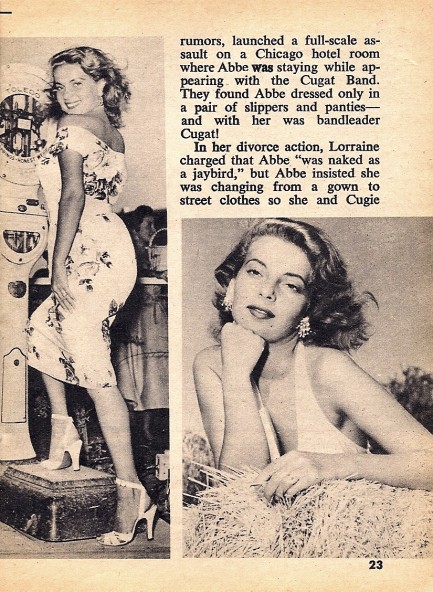
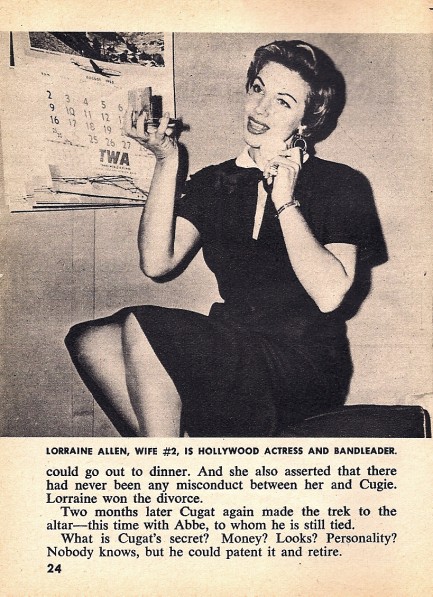
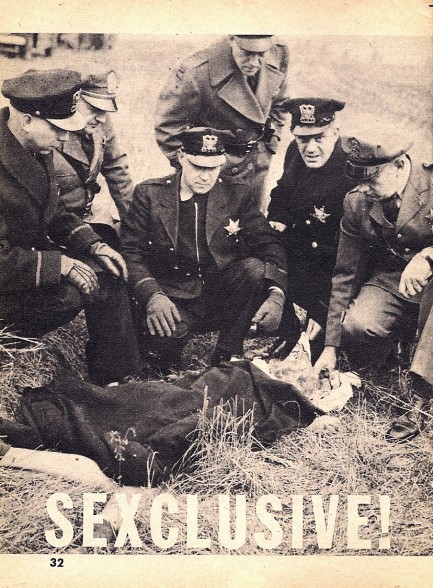
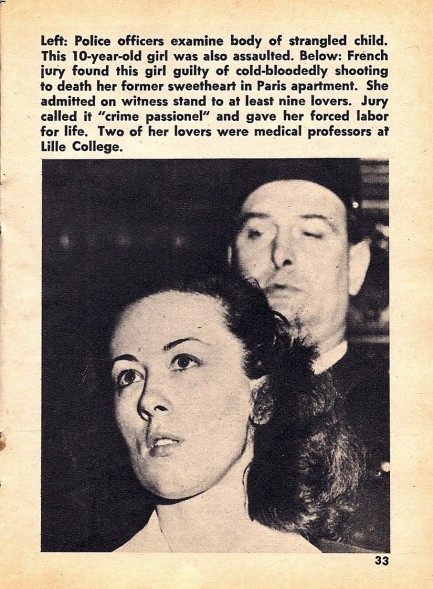
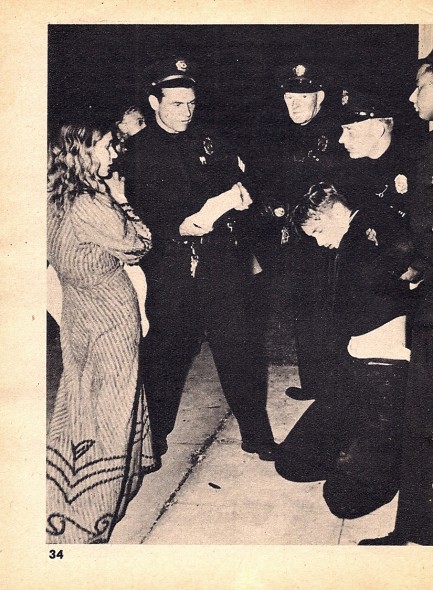
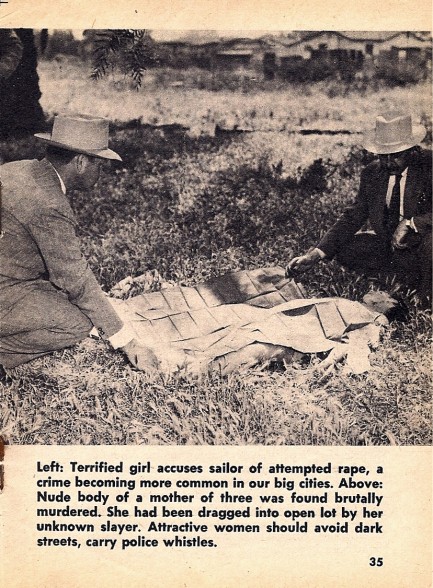
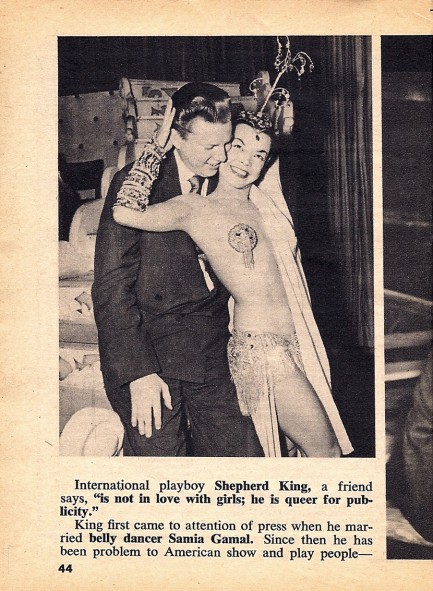

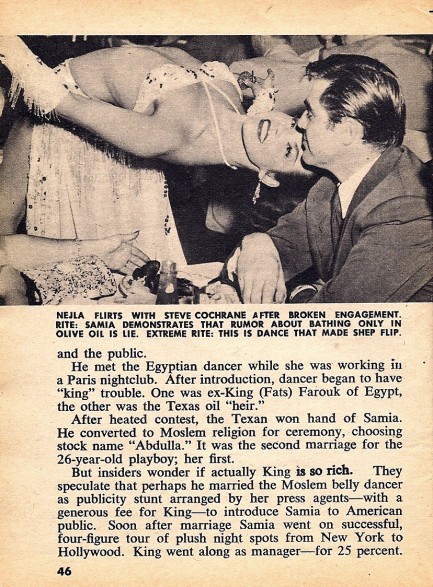
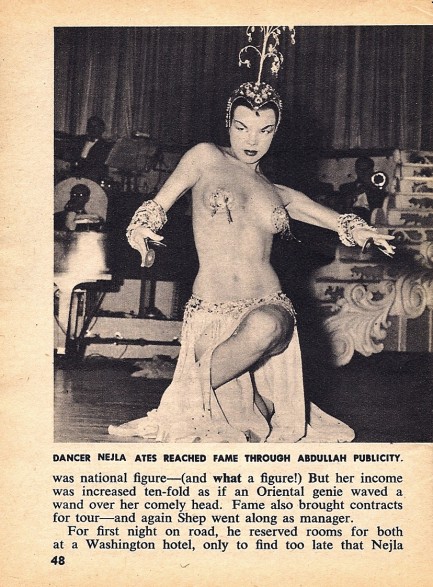

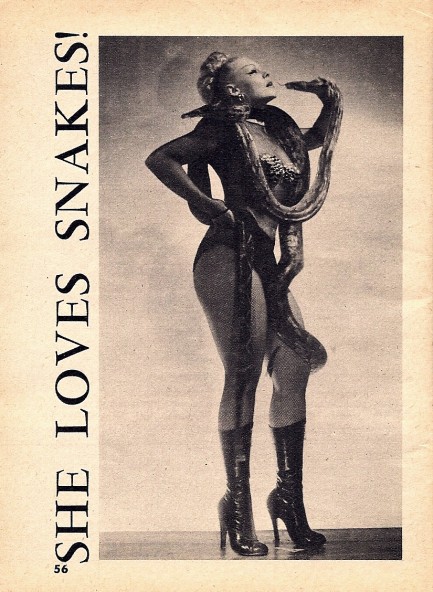

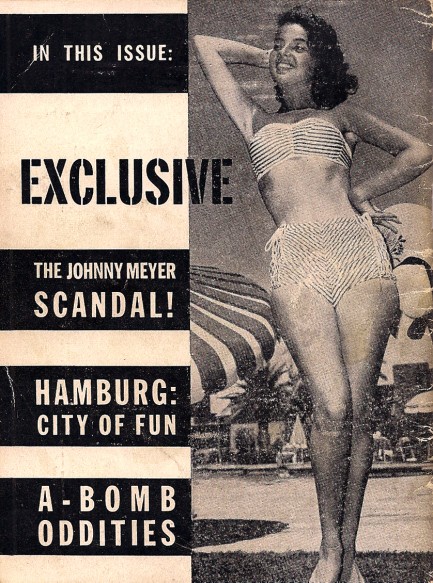















 A long while ago we shared the cover of a 1956 Whisper featuring George Sanders. The same issue had an article on Liberace, and we’re returning to that today as part of our look at mid-century tabloid attitudes toward gay culture. In general of course, the tabloids were brutally insulting, using overt as well as coded language to get intimations of homosexuality across. Theoretically, when dealing with public figures they had to be somewhat cautious, but both Rave and Inside had in 1954 written stories insinuating that Liberace was gay, and in 1955 Suppressed and Private Lives did the same. In Whisper, a journalist writing under the name Sylvia Tremaine refers to Liberace as a “creature,” labels his speech as “simpering,” and describes his move to television this way: “From there it was just a brief flutter to a local TV program.”
A long while ago we shared the cover of a 1956 Whisper featuring George Sanders. The same issue had an article on Liberace, and we’re returning to that today as part of our look at mid-century tabloid attitudes toward gay culture. In general of course, the tabloids were brutally insulting, using overt as well as coded language to get intimations of homosexuality across. Theoretically, when dealing with public figures they had to be somewhat cautious, but both Rave and Inside had in 1954 written stories insinuating that Liberace was gay, and in 1955 Suppressed and Private Lives did the same. In Whisper, a journalist writing under the name Sylvia Tremaine refers to Liberace as a “creature,” labels his speech as “simpering,” and describes his move to television this way: “From there it was just a brief flutter to a local TV program.”  male hormones earmarked for the Liberace boys weren’t hogged by George, leaving Lee with only his nimble fingers.” That goes a bit beyond code, wouldn’t you say?
male hormones earmarked for the Liberace boys weren’t hogged by George, leaving Lee with only his nimble fingers.” That goes a bit beyond code, wouldn’t you say? descriptive text, written for newspaper staff, is meant to simply get across the basic facts of the photos and is typically pretty dry stuff. But this describes Liberace as "the curly-haired pianist" and says his walk is "jaunty." Clear, but deniable.
descriptive text, written for newspaper staff, is meant to simply get across the basic facts of the photos and is typically pretty dry stuff. But this describes Liberace as "the curly-haired pianist" and says his walk is "jaunty." Clear, but deniable.





 was no law, local or federal, which could be applied against shipboard activities. We’ll come back to that in a sec. The other story involves what Confidential describes as the middlesex—i.e. people who lack strong masculine or feminine characteristics. The story is concerned with this only as a social issue and makes no mention of physically intersex persons who genetically are neither male nor female.
was no law, local or federal, which could be applied against shipboard activities. We’ll come back to that in a sec. The other story involves what Confidential describes as the middlesex—i.e. people who lack strong masculine or feminine characteristics. The story is concerned with this only as a social issue and makes no mention of physically intersex persons who genetically are neither male nor female.



 just how certain Confidential editors were that homosexuality was completely beyond the pale. And yet, nearly every issue harped on the subject, either directly or indirectly. For instance, here we get full reportage on a maritime cabaret show featuring drag queens, followed by detailed descriptions of music, dancing, and gambling. You’d almost think the writer Gaye Bird—nice, right?—was actually there.
just how certain Confidential editors were that homosexuality was completely beyond the pale. And yet, nearly every issue harped on the subject, either directly or indirectly. For instance, here we get full reportage on a maritime cabaret show featuring drag queens, followed by detailed descriptions of music, dancing, and gambling. You’d almost think the writer Gaye Bird—nice, right?—was actually there.































 ventured down to Tijuana, Mexico, toured a few brothels, and somehow disappeared alone for two hours: “We don’t know what happened in the house in Mexico or what sights she could have barged in on, but that is bouncy Miss Baker’s bit.” Lost in a Mexican whorehouse. The mind reels. Do we buy it? Not for a minute.
ventured down to Tijuana, Mexico, toured a few brothels, and somehow disappeared alone for two hours: “We don’t know what happened in the house in Mexico or what sights she could have barged in on, but that is bouncy Miss Baker’s bit.” Lost in a Mexican whorehouse. The mind reels. Do we buy it? Not for a minute.
 was one especially bad bruise directly over her kidneys.” The implication here is because Harlow died several years later of kidney failure that she incurred the fatal damage during that wedding night beating. It gets weirder—brace yourselves. Landau goes to Paul Bern’s house, geared for a confrontation:
was one especially bad bruise directly over her kidneys.” The implication here is because Harlow died several years later of kidney failure that she incurred the fatal damage during that wedding night beating. It gets weirder—brace yourselves. Landau goes to Paul Bern’s house, geared for a confrontation:














































































